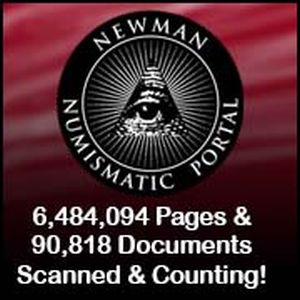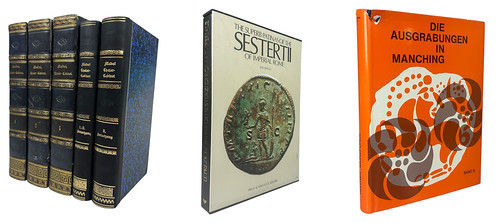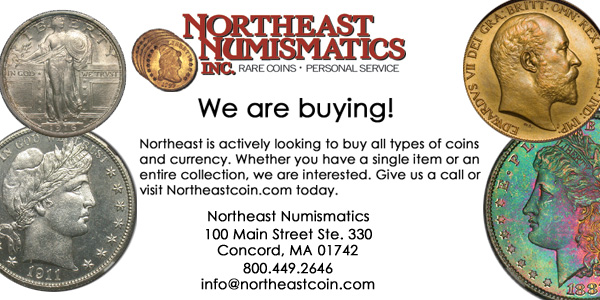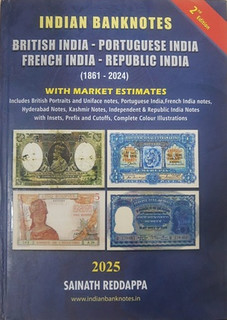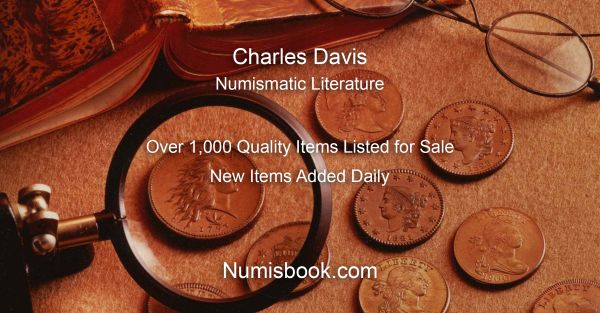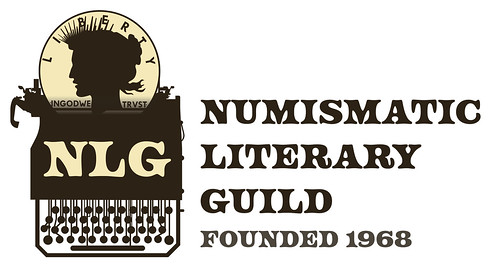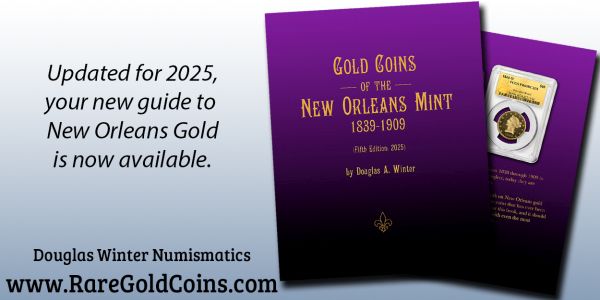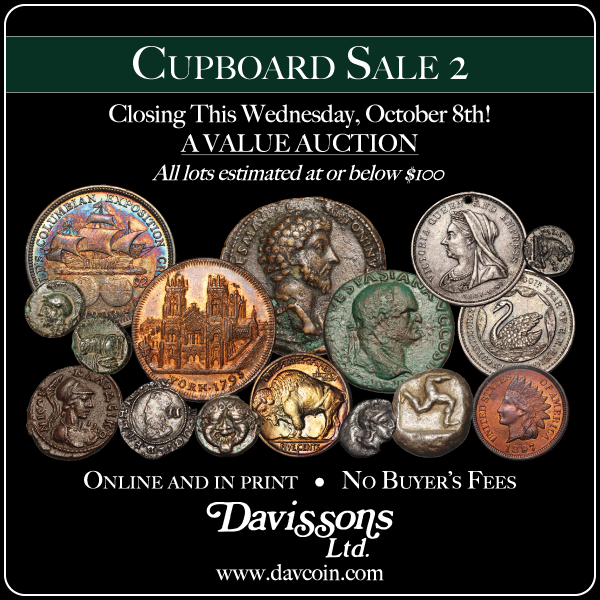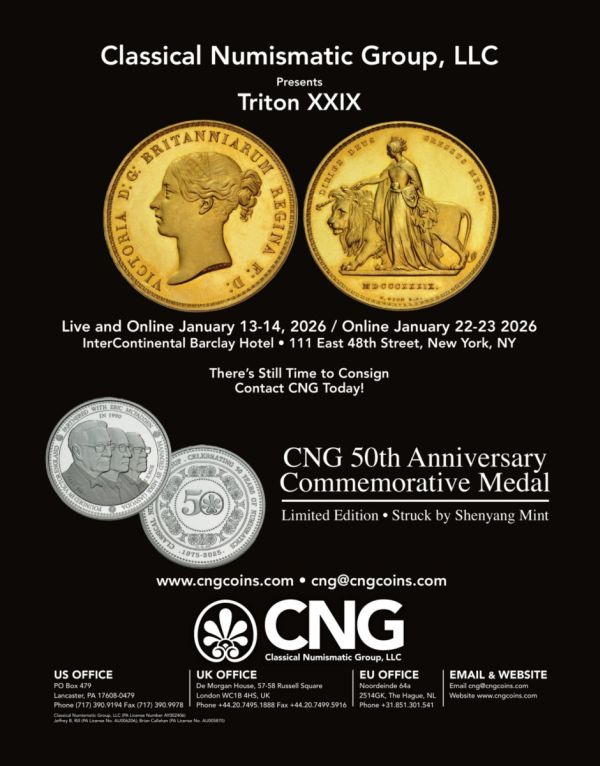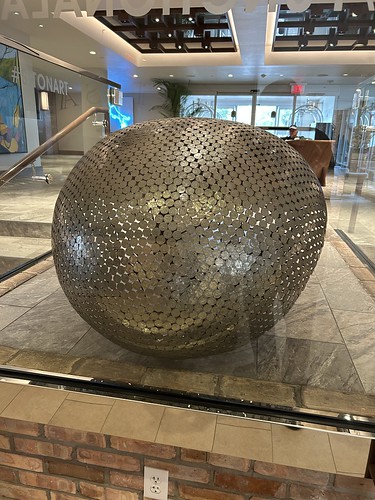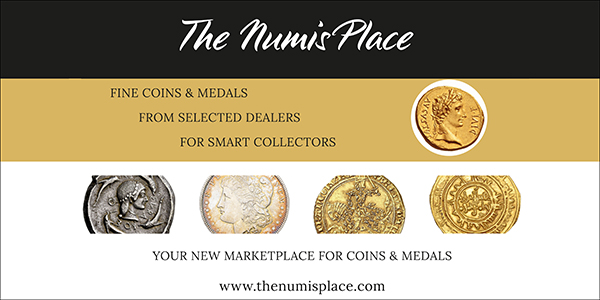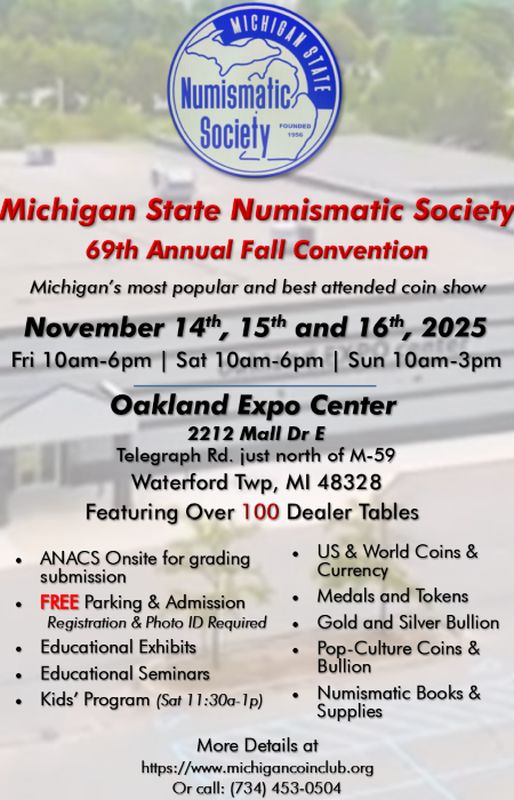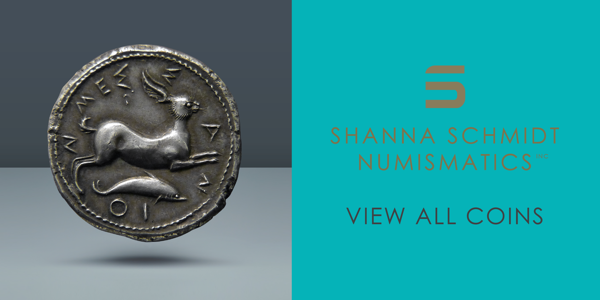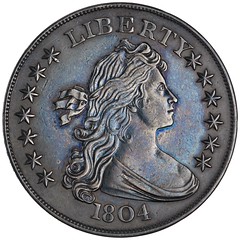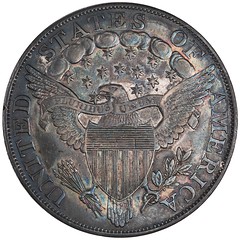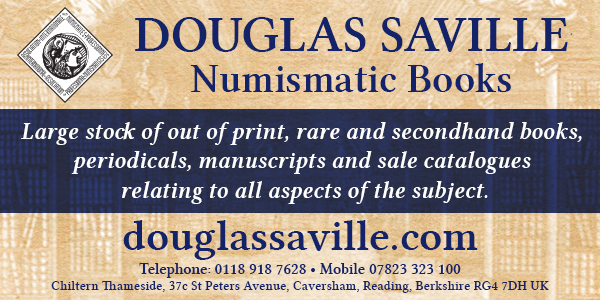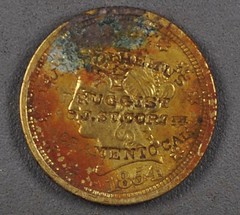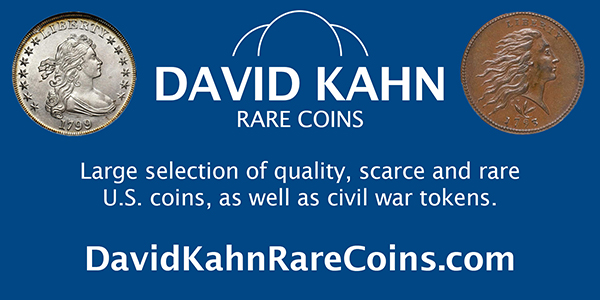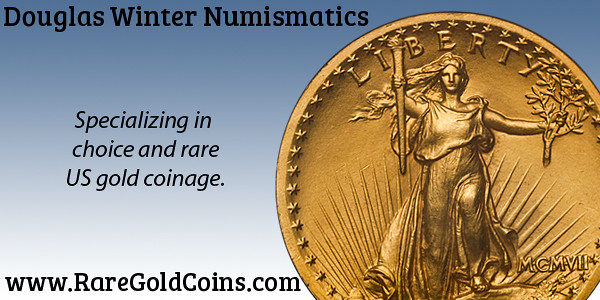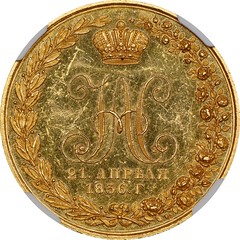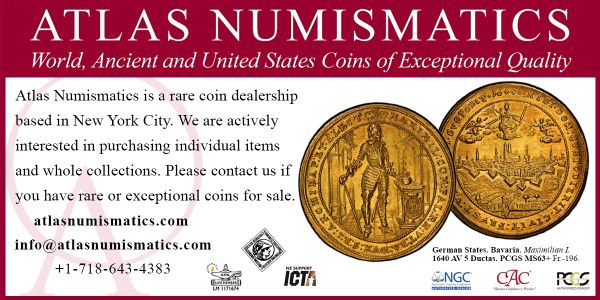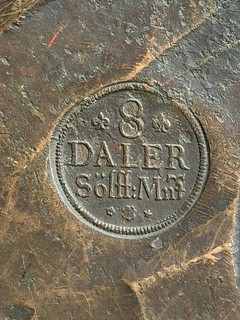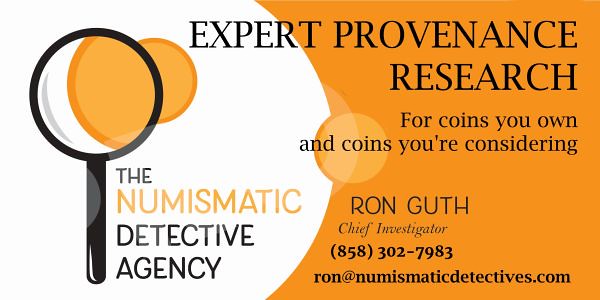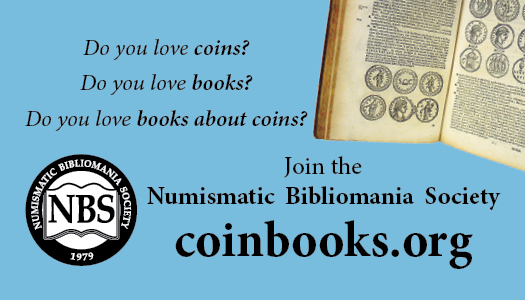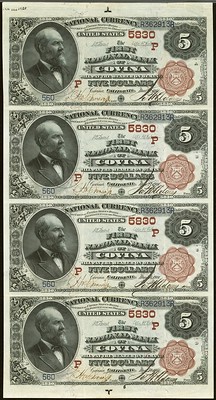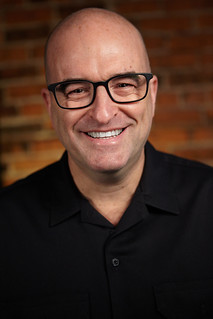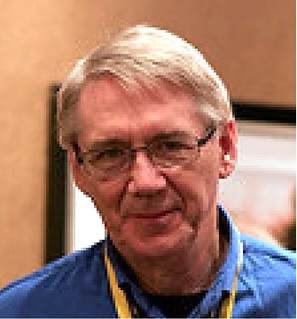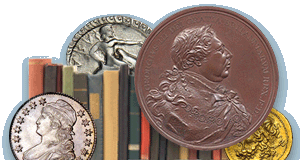
Visit our NBS Sponsors
About UsThe Numismatic Bibliomania Society is a non-profit association devoted to the study and enjoyment of numismatic literature. For more information please see our web site at coinbooks.org SubscriptionsThose wishing to become new E-Sylum subscribers can go to the following web page
Subscribe
MembershipThere is a membership application available on the web site Membership Application To join, print the application and return it with your check to the address printed on the application. Print/Digital membership is $40 to addresses in the U.S., and $60 elsewhere. A digital-only membership is available for $25. For those without web access, write to: Jeff Dickerson, Treasurer AsylumFor Asylum mailing address changes and other membership questions, contact Jeff at this email address: treasurer@coinbooks.org SubmissionsTo submit items for publication in The E-Sylum, write to the Editor at this address: whomren@gmail.com BUY THE BOOK BEFORE THE COINSale CalendarWatch here for updates! |
- WAYNE'S WORDS: THE E-SYLUM OCTOBER 5, 2025
- LANG NUMISMATIC LITERATURE AUCTION 8
- NEW BOOK: MONNAIES FRANCAISES, 1789-2025
- NEW BOOK: INDIAN BANKNOTES 2025
- PERIODICAL: PAN CLARION FALL 2025
- 2025 NLG AWARD: ERIC BROTHERS
- BOHORA'S BANKNOTE STORIES ADDED TO NNP
- VIDEO: MEXICAN WAR OF INDEPENDENCE COINS
- NOTES FROM E-SYLUM READERS: OCTOBER 5, 2025
- U.S. MINTS CASHIER'S DAILY STATEMENTS
- OCTOBER 2025 PAN SHOW SPEAKERS
- ACEF HONORS TWO COUNTERFEIT EDUCATORS
- VOCABULARY TERM: ROMAN GOLD
- 1804 DOLLAR STORIES
- TREASURE TALK WITH BOB EVANS, EPISODE 7.2
- 1715 FLEET: 1,000 COIN TREASURE CHEST FIND
- NUMISMAGRAM MEDAL SELECTIONS: OCTOBER 5, 2025
- HERITAGE: EARLY COPPER AND COLONIAL COINS
- STACK'S: SIGMA COLLECTION OF RUSSIAN COINS
- HERITAGE: GACC CURRENCY SALE
- 2025 GACC SHOW PHOTO ALBUM
- 1659 SWEDISH 8 DALER PLATE MONEY
- COMPANY ADOPTS NEW ‘CASH ROUNDING' POLICY
- CHARLIE KIRK COMMEMORATIVE COIN PROPOSED
- TRUMP COMMEMORATIVE COIN PROPOSED
- TAFT-PEDIGREED $7 COLONIAL NOTE
- HERITAGE: COVINA, CA UNCUT BROWNBACK SHEET
- LOOSE CHANGE: OCTOBER 5, 2025
- ABOUT THIS ISSUE: OCTOBER 5, 2025
Content presented in The E-Sylum is not necessarily researched or independently fact-checked, and views expressed do not necessarily represent those of the Numismatic Bibliomania Society.
WAYNE'S WORDS: THE E-SYLUM OCTOBER 5, 2025
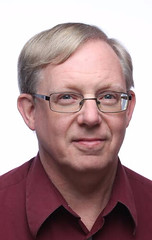 We now have 6,831 subscribers.
We now have 6,831 subscribers.
Thank you for reading The E-Sylum. If you enjoy it, please send me the email addresses of friends you think may enjoy it as well and I'll send them a subscription. Contact me at whomren@gmail.com anytime regarding your subscription, or questions, comments or suggestions about our content.
This week we open with a numismatic literature sale, two new books, a periodical, updates from NLG, NNP, PAN and more.
Other topics this week include French coins and Indian banknotes, coins of the Mexican War of Independence, U.S. Mint chairs and cashier's statements, Roman gold, and 1804 dollars galore.
To learn more about the Libertas Americana medal restrikes, Eric Brothers, Johnny Swing's Quarter Lounge, the Jane Goodall Roots and Shoots medal, Siege Notes of the World, Jack Young, Matt Dinger, the Dreifus-Rosenthal Specimen, the J. L. Polhemus counterstamp, the latest 1715 Fleet recovery, fixed price and auction selections, the Vermont Copper, SS Central America artifacts, slabbed numismatic literature, Swedish copper plate money, proposed commemoratives, and a new "cash transaction policy," read on. Have a great week, everyone!
Wayne Homren
Editor, The E-Sylum
LANG NUMISMATIC LITERATURE AUCTION 8
The eighth numismatic literature auction from Numismatic Antiquarian Bookshop Lang closes October 29, 2025. Here's the announcement. -Editor
We are pleased to announce the 8th literature auction of Numismatisches Antiquariat Lang GmbH. As usual, the auction will take place on the Auex.de platform and will start on October 29, 2025, at 4:00 p.m. (CET).
The auction will also be accessible on the Sixbid, Biddr and Numisbids platforms to give you the greatest possible flexibility in participating.
Some highlights of this auction:
- An extensive library on ancient numismatics
- Other important items from the Jordan library
- Numerous works on the Middle Ages and modern times from other well-stocked libraries
- A large selection of rare and sought-after auction catalogues
Whether you want to expand your library in a specific way or are looking for special rarities, our 8th auction offers a diverse selection of specialist literature on numismatics.
Auction details:
- Date: October 29, 2025
- Location: Online on the auction platform Auex.de
- Time: From 4:00 p.m. CET
We cordially invite you to find out more about the auction in advance at Auex.de or via our homepage (www.numismatisches-antiquariat.de). We are happy to answer any questions you may have or provide personal advice.
Save the date and join us!
NEW BOOK: MONNAIES FRANCAISES, 1789-2025
Collectors of U.S. coins have the Red Book. Collectors of French coins have the Rouge Book. Here is the announcement for the latest edition of the Gadoury book on French coins. -Garrett
 Monnaies Françaises 1789-2025
Monnaies Françaises 1789-2025
By: Maison Gadoury
It is with great pleasure that we announce the release of the new edition of Monnaies Françaises 1789–2025 by Gadoury, the essential reference catalogue for French numismatics from the Revolution to the present day.
Complete, richly illustrated, and fully updated, this volume is an indispensable tool for collectors, dealers, and researchers alike.
What's new in this edition:
Numerous new photographs: sourced from an in-depth analysis of international auction sales, the quality of the illustrations has been significantly enhanced.
High-definition images: many coins that were previously shown only as drawings are now presented in HD, including those originally published in Mazard's work Histoire Monétaire et Numismatique Contemporaine 1790–1967.
Previously unpublished coins: our experts have recorded pieces and variants that have never been catalogued before.
Updated valuations: extensive work has been carried out based on international auction results to provide accurate estimates depending on the state of preservation.
Format: 704 full-colour pages
PRE-SALE: please note that we cannot guarantee any shipping timeframes. Deliveries may take considerably longer than usual.
For more information, or to order, see:
Monnaies Françaises 1789-2025
(https://www.gadoury.com/en/books/monnaies-francaises-2025)
NEW BOOK: INDIAN BANKNOTES 2025
Kavan Ratnatunga passed along recent offerings from Indian numismatic book publisher IIRNS Publications. Thanks. One of the most recent offerings is this book on Indian paper money. -Editor
Author(s): Sainath Reddappa
Pages: X+657 Pages
Published by: Sainath Reddappa
Date Published: 2025
Format: HardCover
ISBN no. 978-93-341-9625-2
Indian Banknotes 2025: British India - Portuguese India - French India Independent and Republic India (1861-2024) is a comprehensive guide to the history of banknotes in India. It covers the period from 1861 till 2024 and includes banknotes issued by British India, Portuguese India, French India, Hyderabad, Kashmir and the Republic of India.
One of the major highlights of this book is the market estimate for each banknote it gives an idea of the current valve of each banknote, and how it has appreciated or depreciated over time. Another important feature of this book is the checkbox. This allows collectors to keep track of the banknotes they own, and the ones they are still looking to acquire.
The book also contains large images of banknotes, which are accompanied by detailed information on the obverse prefix , insets, and other features. This makes it easy for collectors to identify and learn about each banknote, and to appreciate the intricate details that make each banknote unique.
For more information, or to order, see:
Indian BankNotes
(https://www.iirnspublications.com/catalogue/indian-banknotes_293/)
For more book listings, see:
https://www.iirnspublications.com/
PERIODICAL: PAN CLARION FALL 2025
The Fall 2025 issue of The Clarion from the Pennsylvania Association of Numismatists (PAN) has been published, as the group readies itself for their upcoming fall show. I expect to attend, and hope to see many E-Sylum readers there as well. -Editor
Table of Contents
Editor's Desk
Using a great design again, and again—the Buffalo nickel
by Mark Benvenuto
The Libertas Americana medal
by Malcolm Johnson
The ICE Man—Accumulator?
by Rob Throckmorton
A quick guide to Civil War coinage
by Matt Campbell
Counterstamps: Window into the past
by Greg Bennick
The great gold heist of 1933: A lesson in power and pretext
by Blaine Schiff
Fall Show schedule
The 1930 Buffalo nickel—good value?
by Andy Wedding
The commoditization of coins
by Matt Campbell
PAN KidZone flyer and auction lots
PAN News
PAN Member Club News
Here are editor Matt Campbell's notes on the issue. -Editor
 With the fall issue of The Clarion,
I'll have been editor for two years.
This issue, with the most articles
from many talented writers, is the
best yet. Everyone who contributes to the magazine had extra
motivation, as The Clarion was
recognized by the American Numismatic Association at the 2025 World's Fair of Money
with the 2024 Barbara J Gregory Outstanding Regional
Publication award. The Clarion took first place, building
on awards received during Richard Jewell's editorship
(see page 38). The ANA considers publications on a variety of factors, and we always strive to present informative,
inspiring, and useful articles to get that simmering passion
for numismatics boiling. I hope reading The Clarion gives
you ideas and motivation, and arms you with the information to assemble a fine collection affordably. That's an
edifying combination. Thanks to 2024's contributors: Harry Waterson, Mark Benvenuto, Brett Irick, Pat McBride,
Malcolm Johnson, Michael Hicks, Paul and Loretta
Schultz, Greg Magee, Scott Schechter, and Patrick Hipple.
With the fall issue of The Clarion,
I'll have been editor for two years.
This issue, with the most articles
from many talented writers, is the
best yet. Everyone who contributes to the magazine had extra
motivation, as The Clarion was
recognized by the American Numismatic Association at the 2025 World's Fair of Money
with the 2024 Barbara J Gregory Outstanding Regional
Publication award. The Clarion took first place, building
on awards received during Richard Jewell's editorship
(see page 38). The ANA considers publications on a variety of factors, and we always strive to present informative,
inspiring, and useful articles to get that simmering passion
for numismatics boiling. I hope reading The Clarion gives
you ideas and motivation, and arms you with the information to assemble a fine collection affordably. That's an
edifying combination. Thanks to 2024's contributors: Harry Waterson, Mark Benvenuto, Brett Irick, Pat McBride,
Malcolm Johnson, Michael Hicks, Paul and Loretta
Schultz, Greg Magee, Scott Schechter, and Patrick Hipple.
In this issue, PAN member Rob Throckmorton contributes "The ICE Man—Accumulator?" In this enjoyable piece, he distinguishes between a thoughtfully assembled collection and a hodgepodge accumulation of stuff. Both are virtuous in their own way, and Rob is always refreshing—he should be dubbed "The Joyful Collector." On the opposite end, I explore numismatic Big Business in "The commoditization of coins." Ultimately, our beloved classic coins are too unique to be widgetized for investment funds.
Longtime contributor Mark Benvenuto writes about James Earle Fraser and the iconic Buffalo nickel design in "Using a great design again, and again—the Buffalo nick el." It's wonderful to see the designs of classic coins be resurrected on modern gold or silver coins, where the artists' designs can be rendered in a proof strike. Andy Wedding from GreatCollections coincidentally picks out a Buffalo in "The 1930 Buffalo nickel—good value?" He highlights a superb sample with a strike from an early die state and contrasts it with another example from a later die state.
In a similar vein to Mark's piece about the various incarnations of the Buffalo nickel design, Malcolm Johnson explores an iconic piece in "The Libertas Americana medal." While few collectors can obtain an original strike, Malcolm shows us there's opportunity to include this design in our collections through restrikes.
I also kicked off a practical series with "A quick guide to Civil War Coinage." People often like to collect coins from certain historical events, and this article simply lays out the dates to look for to assemble a set most affordably and bypass tougher dates. In a future issue, I'll look at 1812.
PAN life member and assistant bourse chairman Blaine Schiff shows us while the singer may change, the tune stays the same in "The great gold heist of 1933: A lesson in power and pretext." And, Greg Bennick writes about counterstamped coins, an ingenious method of free advertising, in "Counterstamps: Window to the past." He will be a guest lecturer at the PAN show Friday, October 17.
A theme that emerged across numerous articles this issue concerns strike of circulation coins. The US Mint has always been a factory with production targets to meet. Often, the Mint used worn dies, or struck coins with less pressure to extend the life of dies, creating coins with mushy detail. Three walking liberty halves are shown below to illustrate the point. The 1937 proof captures all of the glory of Weinman's design and the 1938-D (center) at MS67+ is an incredible business strike. The 1919-D, MS-64 CAC, was described by Stack's Bowers as a "severe strike rarity." Coins of that issue exhibit flat strikes, and there are less than 20 coins in MS-65 and MS-66 between NGC and PCGS. With grading, there's always more to learn!
Congratulations to Matt and PAN on their First Place Barbara J Gregory Outstanding Regional Publication award. I'm a proud Life Member and Past President of PAN, and have watched with pride and awe as the group just keeps on getting better and better with each passing year. Their shows are top in the nation. See the article elsewhere in this issue for a schedule of educational speakers. -Editor
For more information on the Pennsylvania Association of Numismatists (PAN), see:
https://pancoins.org/
2025 NLG AWARD: ERIC BROTHERS
There's been a correction to one of the 2025 Numismatic Literary Guild (NLG) awards announced earlier this year. The author of the winning article in the ANS Magazine was Eric Brothers. The original announcement mistakenly listed ANS Magazine editor Peter van Alfen as the author. -Editor
Eric Brothers, a regular contributor to Numismatic News, recently received a writing award from the Numismatic Literary Guild (NLG). He won in the category "U.S. Coins 1901 to Date (Numismatic Columns or Articles)" for his article, "Liberty in Motion: Adolph Weinman's Iconic Masterpiece," which was published in the American Numismatic Society's ANS Magazine in the Spring of 2025. The article discusses the numismatic history and artistry of the Walking Liberty half dollar (1916-1947). It also covers the supposed inspiration behind Weinman's half dollar, Oscar Roty's Sower coin (1879-1920). Many authors consider Roty's coin to have inspired Walking Liberty; however, Weinman himself never discussed the Sower's impact upon his own work.
Brothers has been a numismatic author for over twenty years. During that time, his written work has been published in Palm Beach Coin News, The Numismatist, Coins, CDN Monthly Newsletter, Financial History, ANS Magazine, and Numismatic News, among other publications. In 2016, he was awarded the American Numismatic Association's (ANA's) First Place Heath Literary Award for his article, "The Brilliant & Corrupt Franklin Peale," published in the October 2015 issue of The Numismatist. Over the years, Brothers has earned other literary awards from the NLG and the ANA. He has been an active member of the American Numismatic Society since 2023 and has written for them since 2022. He attributes his success in numismatic writing to four important people who have provided guidance and inspired him over the years: Tony Swicer, the President of the Palm Beach Coin Club; Barbara Gregory, the former editor of The Numismatist; Jesse Kraft of the ANS; and Peter Van Alfen, his editor at the ANS.
For more on the American Numismatic Society, see:
https://numismatics.org/
To read the earlier E-Sylum article, see:
2025 NUMISMATIC LITERARY GUILD AWARDS
(https://www.coinbooks.org/v28/esylum_v28n35a03.html)
BOHORA'S BANKNOTE STORIES ADDED TO NNP
The latest addition to the Newman Numismatic Portal is Banknote Stories by Anil Bohora. Project Coordinator Len Augsburger provided the following report. -Editor
Newman Portal Adds Banknote Stories, by Anil Bohora
 The latest installment in Anil Bohora's ongoing series on world paper money, Banknote Stories, is now available on Newman Portal. Bohora writes in the introduction: "Every banknote tells a story. There is visual interplay between the various elements on the banknotes. In this way, a banknote resembles a well-rounded story that includes a fascinating plot and characters…In this book some of the topics I have covered include banknotes reflecting the impact of hyperinflation, banknotes with hidden messages and secrets, banknotes with a difference, different materials used to make banknotes, banknotes telling us war stories, banknotes as works of art, etc."
The latest installment in Anil Bohora's ongoing series on world paper money, Banknote Stories, is now available on Newman Portal. Bohora writes in the introduction: "Every banknote tells a story. There is visual interplay between the various elements on the banknotes. In this way, a banknote resembles a well-rounded story that includes a fascinating plot and characters…In this book some of the topics I have covered include banknotes reflecting the impact of hyperinflation, banknotes with hidden messages and secrets, banknotes with a difference, different materials used to make banknotes, banknotes telling us war stories, banknotes as works of art, etc."
This is Bohora's 11th contribution to Newman Portal, with previous works focused on Indian scrip, fiscal paper, world banknotes, and short snorters.
Link to Anil Bohora's books on Newman Portal:
https://nnp.wustl.edu/library/booksbyauthor/548760
To read the earlier E-Sylum article, see:
NEW BOOK: BANKNOTE STORIES
(https://www.coinbooks.org/v28/esylum_v28n39a06.html)
VIDEO: MEXICAN WAR OF INDEPENDENCE COINS
The David Lisot Video Library on the Newman Numismatic Portal can be found at:
https://nnp.wustl.edu/library/multimediadetail/522852
We highlight one of his videos each week in The E-Sylum. Here's one from 2009 with Ricardo DeLeon speaking about the coins of the Mexican War of Independence.
Excellent presentation - well worth watching. -Editor
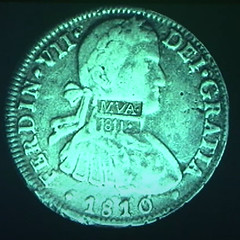 The Mexican War of Independence was an armed conflict fought between the people of Mexico and the Spanish colonial authorities from 1810-1821. During that time many different numismatic issues were circulated creating a rich legacy for collectors today. See and learn about these different coins from numismatist, schoolteacher and former news reporter Ricardo DeLeon.
The Mexican War of Independence was an armed conflict fought between the people of Mexico and the Spanish colonial authorities from 1810-1821. During that time many different numismatic issues were circulated creating a rich legacy for collectors today. See and learn about these different coins from numismatist, schoolteacher and former news reporter Ricardo DeLeon.
Speaker: Ricardo de Leon Tallavas. December 15, 2009.
To watch the complete video, see:
Coins of the Mexican War of Independence
(https://youtu.be/rKHJJTHXhw4)
Coins of the Mexican War of Independence
(https://nnp.wustl.edu/library/book/549084)
NOTES FROM E-SYLUM READERS: OCTOBER 5, 2025
The Mint Remains Open
Len Augsburger passed along this Facebook post from the U.S. Mint noting that they're operating normally during the U.S. government shutdown. Thanks. -Editor
#DYK? The United States Mint's programs are self-sustaining and operate at no cost to the taxpayer.
The Mint remains open for business, including tours and gift shops at our Denver and Philadelphia facilities, as well as our coin store in Washington, D.C.
How is this possible? The Mint is funded by its own Public Enterprise Fund, not by annual appropriations.
More info can be found on our website https://www.usmint.gov/about/tours-and-locations
To read the complete Facebook post, see:
https://www.facebook.com/100064938992077/posts/1199565772218045/
Fond Memories of Istanbul and Cairo
Jeff Burke writes:
"Norman Nicol's bio brought back several fond memories for me. Dr. Uner Turgay, one of my dissertation advisors at McGill, was awarded a Fulbright to pursue a Ph.D. at the University of Wisconsin-Madison. Turgay conducted his dissertation research at the Ottoman archives in Istanbul, his home city. I remember Uner showing me some manuscripts in the Ottoman Turkish script. Dr. Turgay was a Professor of History at the Institute of Islamic Studies, McGill University, from 1976 to 2010.
"I spent two years teaching at Ramses College for Girls (RCG), a private Egyptian school in Cairo, Egypt, from 1981 to 1983. Dr. Harold Vogelaar volunteered to show the new American volunteer teachers at RCG around Cairo. Harold took us to see the Museum of Islamic Art in Cairo, one of our regular stops which we went to several times. At that time, Dr. Vogelaar was a Professor at the Evangelical Theological Seminary in Cairo. He earned a Ph.D. in Middle Eastern languages at Columbia University in 1971. Vogelaar is fluent in several Arabic dialects. Harold lived in the Middle East for a total of 25 years including Bahrain, Oman, Egypt, Israel and Palestine.
"Harold is from a small town in Iowa. I was born and raised in Hastings, Nebraska."
To read the earlier E-Sylum article, see:
MORE FULBRIGHT SCHOLARS IN NUMISMATICS
(https://www.coinbooks.org/v28/esylum_v28n38a14.html)
The Quarter Lounge By Artist Johnny Swing
Joel Orosz writes:
"My wife Florence and I were attending a wedding in Traverse City, Michigan last weekend, and found this numismatic sculpture in the lobby of the Delamar Hotel. Employing an abundance of caution, I opted against trying to sit upon it.
"Swing used 27,000 welds to attach 5,000 quarters to a stainless steel infrastructure. Assuming that all of the quarters are clad, that gives us a base value of $650 for this work of art. "
Thanks! Great exhibit. We saw this first in 2010 when Kay Olson Freeman spotted it in a New York City exhibit. -Editor
To read the earlier E-Sylum article, see:
JOHNNY SWING'S COIN FURNITURE
(https://www.coinbooks.org/esylum_v13n13a24.html)
Jane Goodall Roots and Shoots Medal
Here's a timely artwork I came across myself this week - a medal of the late primatologist and anthropologist Jane Goodall, posted on Facebook by the artist Nicola Moss. -Editor
To read the Facebook post, see:
https://www.facebook.com/share/1BVCBaNWdY/
For more information on Jane Goodall, see:
Conservationist Jane Goodall, whose work revolutionized the study of primates, has died
(https://www.cnn.com/2025/10/01/europe/jane-goodall-death-latam-intl)
U.S. MINTS CASHIER'S DAILY STATEMENTS
Roger Burdette submitted this research note offering U.S. Mint documents from the National Archives that may be of use to fellow researchers. -Editor
Research note from Roger W. Burdette:
A compilation of Cashier's Daily Statements for the following years and mints have been completed to a usable level, and are available to any member free on request. None of the files are absolutely complete with all 305 daily reports; missing items will be added if/when located.
- 1900 New Orleans Mint Cashiers Daily sm.pdf
- 1900 New York Assay Office Cashiers Daily sm.pdf
- 1900 Philadelphia Mint Cashiers Daily sm.pdf
- 1900 San Francisco Mint Cashiers Daily sm.pdf
- 1904 New Orleans Mint Cashiers Daily sm.pdf
- 1904 New York Assay Office Cashiers Daily Statement sm.pdf
- 1904 Philadelphia Mint Cashiers Daily sm.pdf
- 1904 San Francisco Mint Cashiers Daily sm.pdf
- 1905 New Orleans Cashier Daily Jan-Jul sm.pdf
- 1905 New York Assay Office Cashier Daily Jan-Jul sm.pdf
- 1905 Philadelphia Cashier Daily Jan-Jul sm.pdf
- 1905 San Francisco Cashier Daily Jan-Jul sm.pdf
- 1923 Philadelphia Cashier Daily Statement Jan-Jul sm.pdf
- 1930 Denver Cashier Daily Statement sm.pdf
- 1930 San Francisco Cashier Daily Statement sm.pdf
- 1931 Denver Cashier Daily Statement.pdf
- 1932 Denver Cashier Daily Statement sm.pdf
- 1932 Philadelphia Cashier Daily.pdf
- 1933 Denver Cashier Daily Statement sm.pdf
- 1933 Philadelphia Cashier Daily.pdf
- 1934 Denver Cashier Daily Statement sm.pdf
- 1934 Philadelphia Cashier Daily.pdf
- 1935 Denver Cashier Daily Statement sm.pdf
- 1936 Denver Cashier Daily Statement sm.pdf
The notation "sm" prior to the file type (.pdf) indicates the file size was reduced by limiting backward compatibility to about the last 5 years. This should not be a problem for users.
Cashier's Daily Statements can be delivered by Dropbox or other ftp application.
Additional daily statements are being digitized, with emphasis on earlier dates. Progress will be announced from time to time.
THE BOOK BAZARRE
OCTOBER 2025 PAN SHOW SPEAKERS
On Friday, October 17, 2025 the Pennsylvania Association of Numismatists (PAN) will host a series of educational speakers at their fall show in the Pittsburgh suburb of Monroeville, PA. And on Saturday the 18th there's more for young numismatists. Here's the schedule. -Editor
Friday, October 17
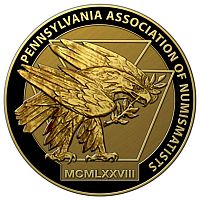 12:00pm – V. Kurt Bellman, numismatist, PAN exhibit judge
12:00pm – V. Kurt Bellman, numismatist, PAN exhibit judge
Topic: "The Joys and Foibles of Collecting British Coins"
1:00pm – Owen Seymour, former grader PCGS
Topic: "Coin Grading Tips and Tricks"
2:00pm – Greg Bennick, TAMS and CONECA board member
Topic: "US Merchant Counterstamps: Coins That Tell Their Own Story"
3:00pm – Dr. Lawrence Korchnak, author, numismatist
Topic: "Siege Notes of the World 1793-1913"
4:00pm – John Frost, Liberty Seated Collectors Club, Barber Coin
Collectors' Society
Topic: "Liberty Seated and Barber Coins of the New Orleans Mint"
Saturday, October 18
1:00pm - American Living History Presentation
2:00pm - Robert O. Stakeley, Heinz History Center, Educational Director
PANKidZone Program: short talk, games, prizes, Kid's auction
To read the complete show schedule, see:
https://pancoins.org/wp-content/uploads/2025/09/SHOW_SCHEDULE_Oct2025a.pdf
For more information on the Pennsylvania Association of Numismatists (PAN) and their fall show, see:
https://pancoins.org/
ACEF HONORS TWO COUNTERFEIT EDUCATORS
Collector Jack Young of Dayton, OH, and coin dealer Matt Dinger of Indianapolis, IN, were honored by the Anti-Counterfeiting Educational Foundation at a special awards ceremony Sept. 26 during the Great American Coin and Collectibles Show in Rosemont, IL for their work in identifying and creating awareness of counterfeit coins. -Garrett
Don Ketterling, a member of the ACEF Board of Directors, presented Dinger with the Alan Kreuzer Memorial Award 3-inch bronze medal. Young, who was unable to attend the ceremony due to a family medical emergency, will receive his medal award in Dayton.
The award is named for the late Alan "Al" Kreuzer, a Castro Valley, CA, coin dealer who was instrumental in alerting the hobby about counterfeit third-party certification holders and fake insert labels. After his death in 2016, his daughter, Chandra, donated $50,000 to establish the award and to help launch the Anti-Counterfeiting Task Force, now integrated into the work of ACEF.
 Young, an engineer by training, collects low-grade large cents. He began collecting as a youth and encountered his first large cent when his grandmother took him to a coin shop in the Dayton Arcade. He joined Early American Coppers in 2002 and became interested in deceptively struck counterfeits in the fall of 2015 by a friend and an EAC dealer's discovery of a fake 1798 "S-158" large cent.
Young, an engineer by training, collects low-grade large cents. He began collecting as a youth and encountered his first large cent when his grandmother took him to a coin shop in the Dayton Arcade. He joined Early American Coppers in 2002 and became interested in deceptively struck counterfeits in the fall of 2015 by a friend and an EAC dealer's discovery of a fake 1798 "S-158" large cent.
Young's counterfeit research during the ensuing years has led to more than 100 published articles about counterfeits in state and national numismatic organizational journals and commercial numismatic publications as well as to contributions published in books on various series. He is founder of two Facebook groups with the primary mission of educating the collecting public about counterfeits: "The Dark Side" group, which now has more than 800 members, and the "Fun with Fakes" group that has grown to 250 members in the past year.
He has also assisted ACEF with presentations about counterfeits and their effects on the hobby and marketplace in meetings with staff of the U.S. Senate Finance Committee, Secret Service agents, and Customs and Border Protection staff.
He received the Professional Numismatic Guild's Sol Kaplan Award in 2021 in recognition of his work to remove counterfeit coins from ecommerce platforms and the ACEF's Alan Kreuzer Award in 2019 for service rendered as an expert in identifying counterfeit coins.
Dinger began collecting coins at age 7, sold his first coin by age 15, and became co-owner of Lost Dutchman Rare Coins in Indianapolis at age 22. As senior numismatist at Lost Dutchman Rare Coins for the past 20 years he has led the shop's research, sales, and preservation efforts. He has served as president of the Indianapolis Coin Club and is an active member of the Professional Numismatists Guild, Central States Numismatic Society, and the American Numismatic Association.
In 2010 Dinger launched The Coin Show Podcast (www.CoinShowRadio.com), aiming to fill a media gap for engaging, hobbyist-focused coin content. He co-hosts the podcast with fellow creator Mike Nottelmann. The podcast delves into news of both U.S. and world coins, providing context and observations from a broad spectrum of numismatic experts, including those who are on the frontlines of educating the public about counterfeits in the marketplace. To date they have produced 249 episodes, all archived at their website.
Dinger has also served as a consultant to the U.S. Secret Service, the FBI, and the U.S. Postal Inspection Service for investigations dealing with crimes related to coin counterfeiting, thefts, and numismatic scams.
Immediately following the award presentation Dinger, Ketterling, and ACEF Executive Director Beth Deisher were featured in a special taping of the Coin Show Podcast.
The Anti-Counterfeiting Educational Foundation is funded entirely by donations. Tax-deductible donations may be made to the 501(c)(3) non-profit Anti-Counterfeiting Educational Foundation by submitting the online donation form at www.acefonline.org.
To read the earlier E-Sylum article, see:
ACEF BESTOWS TWO KREUZER AWARDS
(https://www.coinbooks.org/v28/esylum_v28n38a11.html)
VOCABULARY TERM: ROMAN GOLD
Here's another entry from Dick Johnson's Encyclopedia of Coin and Medal Terminology. -Editor
Roman Gold. Contrasting matte finish and polished surface on the same item that has been goldplated. The term was infrequently used in the jewelry field beginning in 1890s where either bronze, brass or sometimes other alloy was given a matte finish – by light sandblasting or chemical dip – then the contrasting area highly polished before the object was goldplated. The surface would retain the finish of the matte and polished areas but be the color of the goldplate.
In the numismatic field the term was applied to proof surface United States gold coins of 1909-10 (which, of course, were coin gold and not goldplated). The coins bore contrasting sandblast matte and proof polished surfaces. New York coin dealer Abe Kosoff adapted the term, borrowed from the jewelry field, in describing the coins in the early 1940s because the coins bore these contrasting matte and proof surfaces.
When silver is goldplated – in any finish, including matte, polished, a combination of the two, or any other finish – it is called vermeil particularly in modern times. Thus there is no comparable term for silver as there is for gold in Roman gold.
To read the complete entry on the Newman Numismatic Portal, see:
Roman Gold
(https://nnp.wustl.edu/library/dictionarydetail/516675)
1804 DOLLAR STORIES
E-Sylum Feature Writer and American Numismatic Biographies author Pete Smith submitted this article on 1804 dollar stories published over the years. Thanks! Published long before any definitive research on the topic, most newspaper stories were an amusing mix of fact and fiction, and most of the coins discussed were likely fakes such as altered dates. But just because most of the coins were fake doesn't mean all of them were. -Editor
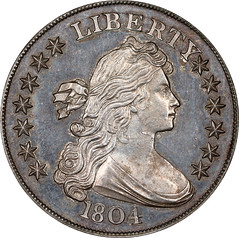 On August 20, 2025, I held in my hand an 1804 Dollar certified as PF-65. This is the sixteenth
known example of an 1804 Dollar. I looked in back issues of newspapers for previous reports of
examples found.
On August 20, 2025, I held in my hand an 1804 Dollar certified as PF-65. This is the sixteenth
known example of an 1804 Dollar. I looked in back issues of newspapers for previous reports of
examples found.
Richmond Independent Telegram, Saturday September 22, 1866.
"The 1804 dollar is the rarest of all dollars; only two of them are known in any collection."
The Fort Wayne Journal Gazette, Thursday September 26, 1878.
"John Maguire of Keil & Bro., is the possessor of a silver dollar dated 1804. There being only four of these pieces in existence, the piece is considered valuable. John was offered one hundred dollars for it yesterday. He says that one thousand dollars will buy it,"
Boston Evening Transcript, Tuesday September 2, 1879.
"Only six of 1804 dollars were struck off."
The Morning News, Tuesday November 20. 1883.
"George T. McComb of Lockport, N. Y., has an 1804 dollar, of which only eight specimens are known to exist."
Chicago Tribune, Saturday February 1, 1890.
"A fact of greatest interest to numismatists is the finding of the missing 1804 silver dollar. Only four silver disks of this date were ever put into circulation. A few days ago Dr. Edward Walther walked into the Commercial National bank and produced the sought-for piece. He had found it in the southern part of the state, where it had reposed, no one knows how long, in the stocking of a Norwegian." [Found in 31 papers]
The Jersey City News, Wednesday January 3, 1894.
"The belief that only seven of the 1804 silver dollars were in existence has been an error, for the eighth one has turned up. Rosenthal Brothers, dealers in old iron, had a debtor in Virginia from whom they tried vainly for some time to collect a bill of $500. Recently the Virginian sent the firm one of the much sought for 1804 dollars. He stated that he sent the coin in payment of his bill, and if the Rosenthals could sell it for more than the total of the account they should keep the balance. In explanation of how he came in possession of the dollar the Virginian wrote that he had bought it for $30 from an old negro, who was ignorant of its rarity and value and in whose family it had been for a long time. The Rosenthals took the dollar to the mint here and it was pronounced genuine." [Variations of the story appeared in 36 papers]
This is now identified as the Class III Dreifus-Rosenthal Specimen, owned by the ANS since 1978.
The Muncie Morning News, Saturday May 12, 1894.
"Harriott, the jeweler, has an 1804 dollar. He has been offered $500 for the coin."
Vermont Phoenix, Friday December 17, 1897.
"A dispatch from Great Falls, Montana, says that the last missing coin of the United States dollar issue of 1804 was brought to light a few days ago in Teton County. A bartender found it among his receipts and showed it to a friend who knew its real value. There are only four dollar coins of the 1804 issue, and the one found in Montana will bring $8000 to $10,000 if it proves to be genuine,"
Falls City Daily News, December 31, 1897.
"N. D. Todd, superintendent of the Chicago & Atchinson bridge, has a dollar of 1804. There are two others in existence, and they are said to be worth $2,000 each. [Found in four papers]
L. T. Altwein of St. Joe, owns one of the two 1804 dollars admitted to be genuine, paying $1,000 for it."
The Bunceton Eagle, Friday November 11, 1898.
"Christopher P. Gallagher, a Bangor grocer, recently discovered in his collection of old coins what appears to be an American silver dollar of the coinage of 1804, said to be worth about $1,100. Where or when he got it Mr. Gallagher does not know, but he's glad to have the old dollar, and is now negotiating for its sale to a New York collector." ]This story appeared in 45 papers]
Middleton Daily Argus, Thursday December 8, 1898.
"John T. Robertson has an 1804 dollar. It was left to him by his wife's father, Joseph Hallett, who died at Waverly."
The Seattle Star, February 18, 1901.
"O. S. Anthony, living near the West street power house has an 1804 dollar which he found several days ago. It is said to be worth $1,100. In 1804, the United State mint at Philadelphia burned, and very few of the dollars were issued that year."
The Beloit Daily Free Press, Tuesday August 11, 1901.
J. T. Deveux, a wealthy ice dealer of Chicago, has paid to J. A. Ryan, a Berkley saloon keeper, $2.90 for a dollar coined in 1804. Deveux made a special trip to Norfolk, Va., to purchase the coin, says the Chicago News. Ryan while digging the foundation for a house found the dollar. [This story appeared in 14 papers]
Leader Telegram. Saturday August 10, 1907.
"S. Gelhaar, the furrier, has an 1804 dollar in a good state of preservation, considering that it is over one hundred years old. Mr. Gelhaar has had his for eighteen years. Anyone can see it by calling at his place, on Eau Claire street."
New York Tribune, Friday December 9, 1910.
"Two of the rare United States silver dollars of the 1804 issue turned up here today. They were found by Miss Mabel Smith, executrix, among the property of the late John C. Comfort, a well-known patent attorney who died two weeks ago," [Variations of the story appeared is sixteen papers]
The Rutland Daily Herald, Friday November 29, 1912.
"A fine specimen of the 1804 American dollar, one of the most valuable coins in existence, was picked up by accident from a homesteader on the New Pacific coast lines of the Milwaukee road in South Dakota by Frank N. Webster of this city. The coin is said to be the tenth existing specimen known."
St. Louis Globe-Democrat, Saturday December 27, 1913.
"William Sullivan, a laborer, excavating on the site of the ice rink for the Yale hockey team turned over with his shovel an old jar which rested on a bowlder 7 feet below the surface of the street nearby. Under the bowlder was a silver snuffbox made in Nurenberg, green with oxidation and in it a United States silver dollar, dated 1804, in good condition." [This story appeared in 177 papers]
The Barre Daily Times, Monday February 2, 1920.
"Only two 1804 silver dollars are known to exist. Anybody who finds a third can get a small fortune for it."
The Plain Dealer, Sunday November 27, 1921.
"The long search for the "eighth 1804 dollar" is ended. For years seven of the eight coins of that vintage known to be in existence have been located. The eighth is in Lancaster and is the property of Martin Hettinger. It has reposed in an old bureau drawer for many years."
The Atlanta Journal, Sunday March 4, 1928.
"Mrs. Frank G. Adams, wife of the proprietor of a local movie theater, and ticket taker in the same place, accepted a silver dollar Friday from an unidentified party as payment for a ticket. She made change, tossed the dollar in the till and thought nothing of it. Friday night when she checked up she noticed the dollar was made in 1804. It was such an unusual looking coin that she wired a Fort Worth, Texas coin dealer for its value. Saturday she received a wire offer of $1,250 for the dollar. Only four of the 1804 dollars were coined, it was understood. One was recovered several years ago in Philadelphia.
The Tuscola Journal, Thursday August 24, 1933.
"Smith Hamil, a wholesale grocer in Keokuk, Iowa, has an 1804 silver dollar which is valued by rare coin collectors at $2,500. It is estimated that there are only nine silver dollars of this date in existence." [Found in three papers]
The Iola Register, Thursday July 12, 1934.
"Worn and hungry looking, a Kentucky mountaineer sought to exchange an old coin for currency more readily negotiable. He wandered into the office of a Cincinnati coin collector, Thomas O. Melish, yesterday. The numismatist felt sorry for him, gave him $2 for the coin, The Kentuckian vanished. Only then, said Melish, did he examine the coin closely. It was an 1804 dollar. Only 13 are known to exist." [Found in 109 papers]
 The Des Moines Register issue of Sunday, November 7. 1937, had a large photo of Albert Keppel
holding his 1804 dollar between thumb and forefinger. He had obtained the coin from a tenant
for $375 in settlement of a debt.
The Des Moines Register issue of Sunday, November 7. 1937, had a large photo of Albert Keppel
holding his 1804 dollar between thumb and forefinger. He had obtained the coin from a tenant
for $375 in settlement of a debt.
Los Angeles Evening Citizen News for Tuesday July 7, 1942, had a long story of an 1804 dollar owned by C. E. Gilhausen.
"Gilhousen, 73, obtained the silver dollar he has for sale from a coin collector in the East, a past president of the American Numismatics assn., with whom he has been dealing for over 50 years."
The Solano-Napa News Chronicle, Tuesday May 24, 1949.
"The attorney for the estate said today he will try to determine whether a silver dollar found in the effects of the late Wilbur E, Brooks is of genuine 1804 coinage."
The Boston Evening Transcript for Monday June 8, 1868, had a story about the 1804 dollars.
"About the year 1835, a present of value having been received by our government from the Imaun of Muscat, and they wishing to make to him a suitable acknowledgement, ordered a set of coins to be made for the purpose. The dies of the 1804 dollar being then in the mint were used upon the coins of this denomination, of which it is supposed several were sent."
Thus, the basic story of the 1804 dollars was known by some as early as 1867 but did not become common knowledge for nearly a century.
These examples represent hundreds of appearances in newspapers. I suspect there are many similar examples in other papers. Only the Rosenthal coin is now recognized as authentic.
The stories illustrate the evolution of the number of pieces known and the misinformation that informed collectors in the past.
So where are all of the fake 1804 dollars today? Melted down for silver content? Held in reference collections? Owned by reclusive collectors insisting that they're real? We've documented all the real ones we've found. What about the fake ones? Anyone have one of these? -Editor
To read the earlier E-Sylum articles, see:
JULIUS DREIFUS AND THE 1804 DOLLAR
(https://www.coinbooks.org/v23/esylum_v23n52a16.html)
STACKS BOWERS: UNPUBLISHED 1804 DOLLAR
(https://www.coinbooks.org/v28/esylum_v28n33a09.html)
TREASURE TALK WITH BOB EVANS, EPISODE 7.2
In January, our good friend Bob Evans began publishing a series of blog articles on the Finest Known website detailing his experience as co-discoverer and curator of the treasures recovered from the wreck of the S.S. Central America. Subject of the book "Ship of Gold", many exhibits, countless interviews and articles, books and auction catalogs feature the legendary haul of gold coins, bars, nuggets, gold dust and more from the 1857 shipwreck. Here's another excerpt - see the complete article online. -Editor
One of the delights of numismatics is gazing at a circulated coin and pondering the possibilities of its circulation. How was it used? What did it pay for, and where? For the most part, details such as this are elusive, totally unknowable.
Coins from the S.S. Central America have a real story. We know where they came from. There is a full record, at least from their time on the shipwreck to the time they entered the numismatic market.
In a few rare instances, we can discover a little more of their stories. This is the forensic science of numismatics, part of what makes the subject sing to me.
Inevitably, coins, particularly small coins, are swept up by the dredge, and they would be found by searching the sediment on deck after the dive, any significant finds taken immediately to the secure Coin Room. There were three coins found in the sediment collected during Dive 57, two seawater-effected silver coins and this little wonder.
As it sat on the exam table I saw the counterstamp first. By now this was a familiar stamp to me, although it always delights me. It's one of the more spectacular counterstamps in existence, in my opinion and I'm sure that of many others.
Some merchants in the 19th century used to advertise by stamping their names or the names of their businesses on circulating coins. In this case the merchant, a druggist, wanted you to know much more, and the result was a stamp that is wonderful and popular among collectors of counterstamps. Such stamps are found most commonly on silver and base-metal coins, but on the SSCA we found them on gold. I had seen this stamp before on double eagles, well-centered over the sunburst and ring of stars on the reverse (tails) side.
Mr. Polhemus wanted possessors of these coins to know not only who he was, but where he was and what he did. He commissioned a logotype stamp (a single punch, instead of separate words or letters) with the full information:
"J. L. POLHEMUS / DRUGGIST / 190 J. ST. COR. 7th / SACRAMENTO CAL."
It's almost like you could mail these coins back to him!
Adding to the charm is a miniscule mortar and pestle, just below his name.
Here is the coin after curating, with the reverse surface free of rust and minerals.
So, it wasn't a great rarity. According to Winter (2006, Gold Coins of the New Orleans Mint, 1839 – 1909, 2nd Edition,) in the modern numismatic market, the 1854 is one of the more readily available New Orleans quarter eagles, particularly in the lower grades.
We know that gold mined in California provided almost all the supply at the New Orleans Branch Mint. So it is probable that most or all of the gold that ended up in the alloy of this quarter eagle made in New Orleans came from California.
From there, the gold made it back to California, to J Street in Sacramento. We see that in the druggist's counterstamp. Then it circulated until finding its way headed back to the east on the S.S. Central America. Then it sank, and sat at the bottom of the Atlantic for 157 years until found and rescued.
What an amazing trip!
To read the complete article, see:
Treasure Talk: Episode 7 Part 2
Gold on a long voyage
(https://finestknown.com/treasure-talk-episode-7-part-2gold-on-a-long-voyage/)
For the complete series, see:
Category Archives: Treasure Talk with Bob Evans
(https://finestknown.com/treasure-talk-with-bob-evans/)
To read the earlier E-Sylum article, see:
TREASURE TALK WITH BOB EVANS, EPISODE 1
(https://www.coinbooks.org/v28/esylum_v28n12a12.html)
TREASURE TALK WITH BOB EVANS, EPISODE 2.1
(https://www.coinbooks.org/v28/esylum_v28n13a17.html)
TREASURE TALK WITH BOB EVANS, EPISODE 2.2
(https://www.coinbooks.org/v28/esylum_v28n14a15.html)
TREASURE TALK WITH BOB EVANS, EPISODE 3.1
(https://www.coinbooks.org/v28/esylum_v28n15a16.html)
TREASURE TALK WITH BOB EVANS, EPISODE 3.2
(https://www.coinbooks.org/v28/esylum_v28n17a16.html)
TREASURE TALK WITH BOB EVANS, EPISODE 4.1
(https://www.coinbooks.org/v28/esylum_v28n18a13.html)
TREASURE TALK WITH BOB EVANS, EPISODE 4.2
(https://www.coinbooks.org/v28/esylum_v28n19a20.html)
TREASURE TALK WITH BOB EVANS, EPISODE 5.1
(https://www.coinbooks.org/v28/esylum_v28n22a13.html)
TREASURE TALK WITH BOB EVANS, EPISODE 5.2
(https://www.coinbooks.org/v28/esylum_v28n23a16.html)
TREASURE TALK WITH BOB EVANS, EPISODE 6.1
(https://www.coinbooks.org/v28/esylum_v28n27a14.html)
TREASURE TALK WITH BOB EVANS, EPISODE 6.2
(https://www.coinbooks.org/v28/esylum_v28n30a21.html)
TREASURE TALK WITH BOB EVANS, EPISODE 7.1
(https://www.coinbooks.org/v28/esylum_v28n32a16.html)
1715 FLEET: 1,000 COIN TREASURE CHEST FIND
The 1715 Fleet Society is a non-profit organization that is "dedicated to researching the history of the 1715 Fleet, its loss, rediscovery, and recovery." The 1715 fleet was part of the Spanish New World Treasure Fleets that funded Spain's activities as a world leader.
Each month the group highlights a "Treasure of the Month". This month's treasure is a doozy. Here's an excerpt - see the complete article online. Images and text courtesy of 1715 Fleet – Queens Jewels, LLC. -Editor
The 1715 Fleet Society is truly privileged to be able to present October's Treasure of the Month. Today, the Society has been accorded the honor of being one of the few agencies chosen to announce to the world a significant recovery from one of the wreck sites of the 1715 Fleet. That recovery is the subject matter of our Treasure of the Month.
In the summer of 2025, Captain Levin Shavers and the crew of the M/V Just Right made a significant discovery … over 1,000 silver eight reales coins, along with several gold coins and artifacts found in one location. Nothing like this has been seen in 35 years. Actually, 1990, to be exact. That was the last year that a recovery of this many silver coins found together occurred. This current recovery recalls the glory days of the 1960s, when thousands of silver coins were often found like this on a single day.
Finding so many coins in the same spot suggests that they were part of a chest that came apart when the ships were destroyed in the hurricane that consumed the Fleet on July 31, 1715. There have been two instances in the past where the remains of actual treasure chests were found on Fleet wreck sites.
These chests were recovered near the Cabin Wreck site in July 1965 and June 1967. Ironically, they were found about 80 feet apart. Each chest consisted of three sacks of coins, 1,500 to a sack. So, this is good circumstantial evidence that the find here may indeed be the remnants of the contents of a treasure chest.
These coins show evidence of being buried in the sand for a long time because most are solid coins with good weight. Coins that have been exposed to turbulent waters often are thin and light, unlike our featured treasure coins.
Below are the coins being inventoried by Captain Levin Sanders.
In addition to the remarkable recovery of these silver coins, other treasures were also brought up. Here are several gold two escudos from the Spanish colonial mint at Bogota, as found, along with two eight escudos from the Mexico City mint.
Gold dust and gems were also part of this recovery.
A press release was issued by 1715 Fleet – Queens Jewels, LLC, on September 30, 2025. Here's an excerpt - see the complete article online. -Editor
1715 Treasure Fleet Shipwrecks Valued at $1,000,000.
1715 Fleet – Queens Jewels, LLC, a historic shipwreck salvage operation that owns the exclusive salvage rights to the remains of the 1715 Treasure Fleet, announces remarkable archaeological and historical recoveries.
Over 1000 silver coins known as Reales were recovered by Capt. Levin Shavers and the crew of the M/V Just Right. In addition, 5 gold coins called Escudos and other rare gold artifacts were recovered during the 2025 summer salvage season.
The coins, preserved beneath centuries of sand and sea, are part of the vast fortune carried by the fleet, which was transporting New World riches back to Spain when disaster struck on July 31, 1715. Historians estimate that as much as $400 million worth of gold, silver, and jewels were lost in the storm, making it one of the greatest maritime tragedies—and treasures—of the Americas.
"This discovery is not only about the treasure itself, but the stories it tells," said Sal Guttuso, Director of Operations. "Each coin is a piece of history, a tangible link to the people who lived, worked, and sailed during the Golden Age of the Spanish Empire. Finding 1,000 of them in a single recovery is both rare and extraordinary."
The coins, known as pieces of eight, were minted in the Spanish colonies of Mexico, Peru, and Bolivia. Many still bear visible dates and mint marks, making them important to historians and collectors alike. The condition of the coins suggests they were part of a single chest or shipment that spilled when the ship broke apart in the hurricane's fury.
To read the complete article, see:
October 2025 — Treasure of the Month
(https://1715fleetsociety.com/october-2025-treasure-of-the-month/)
Thanks also to Pablo Hoffman, Leon Saryan, Paul Horner and others who passed along articles on the find. Here's a video. -Editor
For other articles on the topic, see:
Crew finds $1 million worth silver, gold coins on 300-year-old shipwreck in Florida
(https://www.youtube.com/watch?v=RsF8hOmutx8)
$1M worth of gold, silver coins recovered from 1715 Spanish shipwreck, salvage crew says
(https://www.yahoo.com/news/articles/1m-worth-gold-silver-coins-054427290.html)
Divers Recover More Than $1 Million Worth of Gold and Silver Coins From 310-Year-Old ‘Treasure Fleet' Shipwrecks
(https://www.smithsonianmag.com/smart-news/divers-recover-more-than-1-million-worth-of-gold-and-silver-coins-from-310-year-old-treasure-fleet-shipwrecks-180987434/)
$1 million in gold and silver coins discovered from historic 1700s Florida shipwreck
(https://www.foxweather.com/earth-space/coins-discovery-florida-1715-treasure-fleet-shipwreck#google_vignette)
For more information on the 1715 Fleet Society, see:
https://1715fleetsociety.com/
To read the earlier E-Sylum article, see:
(https://www.coinbooks.org/v28/esylum_v28n36a23.html)
NUMISMAGRAM MEDAL SELECTIONS: OCTOBER 5, 2025
Numismagram's Jeremy Bostwick sent along these four medals from his most recent upload of new spooky material to his site. For all of the new items, please visit https://www.numismagram.com/inventory. -Garrett
102972 | GERMANY, GREAT BRITAIN, CHINA & JAPAN. Satire of Kiauchau bronze Medal. Issued 1914. The Defense of Jiaozhou (Kiauchau/Kiautschou) (33mm, 16.59 g, 12h). Crowned eagle (representing Germany) perched in oak tree; to lower left, British officer sending monkey (dressed in Japanese uniform) up the tree in which three other bodies hang lifeless // DER / ENGLÄNDER / UND SEIN JAPANER / "JETZT KLETTRE DU MAL / AUF DIE DEUTSCHE EICHE / UND VERSUCHE, / OB DU IHM NICHT EINE / FEDER AUS DEM SCHWANZ / REISSEN KANNST!" (The Englishman to his Japanese pet: "climb up this oak and see if you can pluck a feather from the eagle's tail!") in nine lines. Edge: Plain. Cf. Zetzmann 4062 (silver). PCGS MS-63. Tan-brown surfaces, with a few stains on the reverse. A very haunting and rare type, made that much more desirable on account of its great state of preservation. $985.
Jiaozhou, an important and strategic naval location, became the focus of German interests at the end of the 19th century, and a 99-year lease was signed with the Qing Dynasty for its use by the German Empire. This lease continued after the fall of the former and during the period of its successor, the Republic of China, until the outbreak of World War I, at which point, the Japanese Empire delivered an ultimatum to Germany, demanding that it relinquish control of the region. This ultimatum was rejected, whereupon Japan began a bombardment of the territory, ultimately resulting in their seizure of Jiaozhou. It was eventually returned to Chinese control in 1922, but was again occupied by the Japanese during World War II.
To read the complete item description, see:
102972 | GERMANY, GREAT BRITAIN, CHINA & JAPAN.
(https://www.numismagram.com/product-page/102972)
103199 | GERMANY, FRANCE, GREAT BRITAIN & OTTOMAN EMPIRE. "The Lunatics in Gallipoli" cast bronze Medal. Dated 1916 (55mm, 67.11 g, 12h). By Karl Goetz in München. DIE / MONDSÜCH / TIGEN • AUF / GALLIPOLI (the lunatics in Gallipoli), British soldier advancing right and holding ship, and French soldier kneeling right and taking aim with rifle; Ottoman crescent to right // The same two men, now lifeless and reduced to skeletons, lying upon an empty battlefield; Ottoman star and crescent above. Edge: Plain. Kienast 169; Klose –; The Art of Devastation –; Frankenhuis 1460; Böttcher Coll. 5470. PCGS MS-61. Pleasing brown surfaces, with lighter highlights and a few hints of green. $795.
Here, Goetz pokes rather morbid fun at the Gallipoli campaign of 1915, in which, as described in The Art of Devastation, "...the Royal Navy attempted to force the straits of the Dardanelles resulting in the humiliating loss of several warships. First Sea Lord John Fischer eventually called off the attempt. Ultimately, the failed Gallipoli campaign led to his resignation and to the resignation of his superior the First Lord of the Admiralty, Winston Churchill." Goetz punningly refers to them as lunatics on account of their utter failure, utilizing the crescent moon iconography of the Ottoman Empire to full effect.
To read the complete item description, see:
103199 | GERMANY, FRANCE, GREAT BRITAIN & OTTOMAN EMPIRE. "The Lunatics in Gallipoli" cast bronze Medal.
(https://www.numismagram.com/product-page/103199)
103033 | BELGIUM. "Religion and Humanity—or the Apocalypse" cast bronze Medal. Issued circa 1932/3 (70mm, 125.03 g, 12h). By Josuë Dupon for the Société Royale Les Amis de la Médaille d'Art, and struck by Fonson. TUTI QUOS SERVAT (safe are those who are guarded), Life: manus Dei emerging left from cloud, cradling two putti and protecting them from hissing coiled serpent below // Death: the Four Horsemen of the Apocalypse; above, rayed Eye of Providence above clouds with inscription AD VITAM ÆTERNAM (to eternal life); below, skeleton lying left on groundline; in two lines in exergue, SIC TRANSIT GLORIA MVNDI (thus passes the glory of the world). Edge: J.FONSON. Buchet & Toussaint 61. Choice Mint State. Olive-brown surfaces. Rare, with an issue of just 367 pieces in bronze. $275.
Produced by the Friends of Medallic Art in Belgium, this powerful piece paints two drastically different, yet related, pictures. In the first, the manus Dei (hand of God) is seen protecting two cherubim from the evilness of the serpent below. In the other, the supine skeleton represents the only earthly remains of the faithful, as the Four Horsemen of the Apocalypse fly above and the devoted follower's passage into heaven is alluded to through the divine Eye.
To read the complete item description, see:
103033 | BELGIUM. "Religion and Humanity—or the Apocalypse" cast bronze Medal.
(https://www.numismagram.com/product-page/103033)
102069 | NETHERLANDS. "Looking at Time 2" cast bronze Medal. Issued 1990 (71mm, 201.55 g, 12h). By the Auguralis group. Serpent coiled left around egg; outward-facing skull to left and right // kijken naar tijd 2 / panta rhei (p??ta ?e?, "everything flows," –adapted from Heraclitus), lemniscate shape, representing infinity. Edge: "1" stamped at the top. De Beeldennar (Jan/Feb 1991), p. 273. As Cast. Black surfaces, with great relief and some glossiness. Incredibly rare, with an output of just 5 pieces, and with this being the first. $325.
From a series of Dutch modern art medals, somewhat similar to the former Society of Medalists series in the United States and BAMS series in the United Kingdom, this entrant from 1990 considers the idea of the passage of time—a very modern take on the concept of vanitas or a memento mori. The egg represents birth or the creation of life, while the serpent—that of its winding journey, and the skull—that of death or the end of the journey. Similarly, this concept is reiterated on the reverse, with a nod to the Heraclitus phrase, p??ta ?e?, or "everything flows." In the middle is a lemniscate shape, representing the seemingly endless, infinite, and somewhat entropic aspect of individual journeys in life.
To read the complete item description, see:
102069 | NETHERLANDS. "Looking at Time 2" cast bronze Medal.
(https://www.numismagram.com/product-page/102069)
HERITAGE: EARLY COPPER AND COLONIAL COINS
Heritage Auctions will be hosting their Early Copper & Colonial US Coins Showcase Auction on October 6. Select items from the Curators' Picks are discussed below. -Garrett
1787 New Jersey Copper, No Sprig Above Plow, M. 45-d, W-5240, High R.5, VG8 PCGS. Hypertrophic Ear. This is a lovely collector-grade example of one of the scarcer 1787 New Jersey copper die varieties. It represents one of two varieties that use Obverse 45, known as the "Hypertrophic Ear" obverse, with an unusually large ear on the horse. We also have an example of the other Obverse 45 variety, 45-E, in this auction, but the current 45-D is the rarer of the two pairings. This is a coin that deserves close attention from Colonials specialists.
To read the complete item description, see:
1787 New Jersey Copper, No Sprig Above Plow, M. 45-d, W-5240, High R.5, VG8 PCGS. Hypertrophic Ear.
(https://coins.ha.com/itm/colonials/1787-new-jersey-copper-no-sprig-above-plow-m-45-d-w-5240-high-r5-vg8-pcgs-hypertrophic-ear-pcgs-population-/a/60486-50039.s)
1785 Vermont Copper, VERMONTS, RR-3, Bressett 2-B, W-2010, R.5, VF25 PCGS. This piece represents one of the rare varieties of the 1785 Vermont copper, rated R.5. Moreover, it is an attractive coin for the grade, devoid of environmental impairments and showing deep copper-red color. The strike is slightly off center as often, but the central eye is boldly defined. These characteristics make this Vermont copper an exceptional piece worthy of attention within the large number of Colonials in this auction.
From The Siesta Key Collection.
To read the complete item description, see:
1785 Vermont Copper, VERMONTS, RR-3, Bressett 2-B, W-2010, R.5, VF25 PCGS.
(https://coins.ha.com/itm/colonials/1785-vermont-copper-vermonts-rr-3-bressett-2-b-w-2010-r5-vf25-pcgs-pcgs-population-0-5-/a/60486-50046.s)
1795 1/2 C Lettered Edge, C-1, B-1, R.2, VG8 PCGS. CAC. I love this coin. As an admirer of early copper overall, I am always interested to see collector-grade type and date coins with problem-free surfaces. However, those problem-free surfaces are somewhat hard to find. The low circulated grades are instead replete with minor or major environmental problems. This piece is evenly worn, uniformly colored, and in all things attractive for the grade. CAC endorsement leaves no doubt as to its quality.
To read the complete item description, see:
1795 1/2 C Lettered Edge, C-1, B-1, R.2, VG8 PCGS. CAC.
(https://coins.ha.com/itm/half-cents/1795-1-2-c-lettered-edge-c-1-b-1-r2-vg8-pcgs-cac-pcgs-population-2-21-and-0-1-cac-population-1-7-mint/a/60486-50110.s)
1829 1/2 C C-1, B-1, R.1, AU55 PCGS. Gold CAC. This is a lovely 1829 Classic Head half cent, showing some original luster in the fields and having only the slightest high-point wear evident over the devices. The deep burgundy and golden-brown colors attest to its originality. However, it is also arguably undegraded at the AU55 level. CAC awards this coin a Gold label, which, in common consideration with the coin's Generation 3.1 green label holder, makes this piece a top-tier date or type coin for the casual collector.
From The Siesta Key Collection.
To read the complete item description, see:
1829 1/2 C C-1, B-1, R.1, AU55 PCGS. Gold CAC.
(https://coins.ha.com/itm/half-cents/1829-1-2-c-c-1-b-1-r1-au55-pcgs-gold-cac-housed-in-a-generation-31-green-label-holder-pcgs-population-53-21/a/60486-50160.s)
1803 1C Small Date, Small Fraction, S-245, B-2, R.3 -- Rare Chinese Counterstamp -- Damaged -- PCGS Genuine. AG Details. PCGS often denotes some counterstamps as "damage." This coin is slightly granular and has deep walnut-brown color with scattered surface marks, so it is not devoid of environmental impairments. However, that is an unusual Chinese counterstamp on the obverse, and that alone makes me like this coin. Counterstamped large cents are not unusual as a whole, but most show U.S. merchant marks, not foreign stampings. One wonders what sort of life this coin had, and how it ended up back in numismatic hands.
To read the complete item description, see:
1803 1C Small Date, Small Fraction, S-245, B-2, R.3 -- Rare Chinese Counterstamp -- Damaged -- PCGS Genuine. AG Details.
(https://coins.ha.com/itm/large-cents/1803-1c-small-date-small-fraction-s-245-b-2-r3-rare-chinese-counterstamp-damaged-pcgs-genuine-ag-details/a/60486-50258.s)
STACK'S: SIGMA COLLECTION OF RUSSIAN COINS
Stack's Bowers will be selling the Sigma Collection of Russian Coinage as part of their October 2025 Hong Kong (SAR) Auction. Select items are discussed below. -Garrett
Lot 43618 (t) RUSSIA. Ruble, 1799-CM MB. St. Petersburg (Banking) Mint. Paul I. NGC MS-63. KM-101; Bit-35.
To read the complete item description, see:
Lot 43618 (t) RUSSIA. Ruble, 1799-CM MB. St. Petersburg (Banking) Mint. Paul I. NGC MS-63.
(https://auctions.stacksbowers.com/lots/view/3-1M0PMS/t-russia-ruble-1799-cm-mb-st-petersburg-banking-mint-paul-i-ngc-ms-63)
Lot 43622 (t) RUSSIA. Ruble, 1803-CNB AN. St. Petersburg Mint. Alexander I. NGC MS-62. KM-C-125; Bit-33.
To read the complete item description, see:
Lot 43622 (t) RUSSIA. Ruble, 1803-CNB AN. St. Petersburg Mint. Alexander I. NGC MS-62.
(https://auctions.stacksbowers.com/lots/view/3-1M0PO6/t-russia-ruble-1803-cnb-an-st-petersburg-mint-alexander-i-ngc-ms-62)
Lot 43626 (t) RUSSIA. Death of Alexander I Gold Medal, "1825". St. Petersburg Mint. NGC MS-61. Diakov-429.2 (R4). Weight: 174.20 gms. Diameter: 62mm. By: A. Klepikov. Obverse: Laureate bust of Alexander I facing right within ouroboros, legend surrounding; Reverse: Radiant all seeing eye surrounded by legend.
To read the complete item description, see:
Lot 43626 (t) RUSSIA. Death of Alexander I Gold Medal, "1825". St. Petersburg Mint. NGC MS-61.
(https://auctions.stacksbowers.com/lots/view/3-1M0PPG/t-russia-death-of-alexander-i-gold-medal-1825-st-petersburg-mint-ngc-ms-61)
Lot 43627 (t) RUSSIA. 10th Anniversary of the Coronation of Nicholas I Gold Medallic 10 Rubles, 1836-CNB. St. Petersburg Mint. NGC PROOF-61 Cameo. Fr-152; KM-Unlisted; Bit-M883 (R3); Sev-425; Diakov-533.1. Weight: 16.5 gms. Obverse: Jugate busts of Nicholas I and Alexandra Feodorovna facing left; Reverse: Crowned monogram within wreath.
To read the complete item description, see:
Lot 43627 (t) RUSSIA. 10th Anniversary of the Coronation of Nicholas I Gold Medallic 10 Rubles, 1836-CNB. St. Petersburg Mint. NGC PROOF-61 Cameo.
(https://auctions.stacksbowers.com/lots/view/3-1M0PPT/t-russia-10th-anniversary-of-the-coronation-of-nicholas-i-gold-medallic-10-rubles-1836-cnb-st-petersburg-mint-ngc-proof-61-cameo)
Lot 43629 (t) RUSSIA. Platinum 3 Rubles, 1828-CNB. St. Petersburg Mint. Nicholas I. PCGS PROOF-62 Cameo. Fr-160; KM-C-177; Bit-73 (R1).
To read the complete item description, see:
Lot 43629 (t) RUSSIA. Platinum 3 Rubles, 1828-CNB. St. Petersburg Mint. Nicholas I. PCGS PROOF-62 Cameo.
(https://auctions.stacksbowers.com/lots/view/3-1M0PQN/t-russia-platinum-3-rubles-1828-cnb-st-petersburg-mint-nicholas-i-pcgs-proof-62-cameo)
Lot 43630 (t) RUSSIA. 1-1/2 Rubles ("Family Ruble") - 10 Zlotych, 1836-NY. St. Petersburg Mint. Nicholas I. PCGS MS-61. Dav-286; KM-C-A172.1; Bit-888 (R2); Julian-1249. With engravers initials: N(Paul) Y(Utkin). Obverse: Bare head of Nicholas (Nikolai) right; Reverse: Busts of Crown Prince Aleksandr Nikolaevich, Grand Duchesses Maria Nikolaevna, Olga Nikolaevna, Alexandra Nikolaevna, and Grand Dukes Konstantin Nikolaevich, Nikolai Nikolaevich, and Mikhail Nikolaevich around central medallion of Alexandra Feodorovna right, wearing stephane.
To read the complete item description, see:
Lot 43630 (t) RUSSIA. 1-1/2 Rubles ("Family Ruble") - 10 Zlotych, 1836-NY. St. Petersburg Mint. Nicholas I. PCGS MS-61.
(https://auctions.stacksbowers.com/lots/view/3-1M0PQY/t-russia-1-12-rubles-family-ruble-10-zlotych-1836-ny-st-petersburg-mint-nicholas-i-pcgs-ms-61)
Lot 43637 (t) RUSSIA. Ruble, 1843-CNB AY. St. Petersburg Mint. Nicholas I. NGC MS-65?. KM-C-168.1; Bit-186.
To read the complete item description, see:
Lot 43637 (t) RUSSIA. Ruble, 1843-CNB AY. St. Petersburg Mint. Nicholas I. NGC MS-65?.
(https://auctions.stacksbowers.com/lots/view/3-1M0PT5/t-russia-ruble-1843-cnb-ay-st-petersburg-mint-nicholas-i-ngc-ms-65)
Lot 43651 (t) RUSSIA. Ruble, 1834. St. Petersburg Mint. Nicholas I. NGC PROOF-61. KM-C-169; Bit-894 (R).
To read the complete item description, see:
Lot 43651 (t) RUSSIA. Ruble, 1834. St. Petersburg Mint. Nicholas I. NGC PROOF-61.
(https://auctions.stacksbowers.com/lots/view/3-1M0PXL/t-russia-ruble-1834-st-petersburg-mint-nicholas-i-ngc-proof-61)
Lot 43653 (t) RUSSIA. Ruble, 1863-CNB AB. St. Petersburg Mint. Alexander II. NGC AU-53. KM-Y-25; Bit-75 (R2). Amongst the most elusive KEY DATES in the entire Ruble series, and certainly the RAREST date of Alexander II's reign.
To read the complete item description, see:
Lot 43653 (t) RUSSIA. Ruble, 1863-CNB AB. St. Petersburg Mint. Alexander II. NGC AU-53.
(https://auctions.stacksbowers.com/lots/view/3-1M0PY9/t-russia-ruble-1863-cnb-ab-st-petersburg-mint-alexander-ii-ngc-au-53)
Lot 43656 (t) RUSSIA. Coronation of Alexander III & Maria Feodorovna Gold Medal, 1883. St. Petersburg Mint. PCGS SPECIMEN-62. Diakov-931.2. By A. Griliches, Jr. Weight: 108.16 gms. Diameter: 51mm. Obverse: Conjoined heads right of Alexander and Maria Feodorovna, diademed; Reverse: Crowned imperial double eagle, with coat-of-arms on breast and holding scepter and orb; garlanded crown above.
To read the complete item description, see:
Lot 43656 (t) RUSSIA. Coronation of Alexander III & Maria Feodorovna Gold Medal, 1883. St. Petersburg Mint. PCGS SPECIMEN-62.
(https://auctions.stacksbowers.com/lots/view/3-1M0PZ8/t-russia-coronation-of-alexander-iii-maria-feodorovna-gold-medal-1883-st-petersburg-mint-pcgs-specimen-62)
HERITAGE: GACC CURRENCY SALE
Heritage Auctions will be hosting their GACC U.S. Currency Signature Auction on October 7 - 10. Select items from the Curators' Picks are discussed below. -Garrett
T5 $100 1861 PF-1 Cr. 5 Jones Signature PMG Very Fine 25. This note was one of nine T-5 $100s issued on August 12, 1861, with serial numbers 2101 - 2109 and bears the signature of C.T. Jones, signing for the Register. At present, this is the only known T5 having Jones sign for Tyler. A comparison of the note versus the plate on page 132 of Fricke's 2014 catalog strongly suggests that this is one and the same note. The back bears two endorsements, the first, in red ink, from William J. Bromwell, disbursing clerk for the Department of State, issuing the note on August 26, 1861, and the second receiving the note and recording its face value plus accrued interest of $4.25. The note has two sealed hammer cancels. A rare chance to acquire an excessively rare note that will take any collection to which it is added to the next level.
To read the complete item description, see:
T5 $100 1861 PF-1 Cr. 5 Jones Signature PMG Very Fine 25.
(https://currency.ha.com/itm/confederate-notes/1861-issues/t5-100-1861-pf-1-cr-5-jones-signature-pmg-very-fine-25/a/3599-20105.s)
Selma, AL- Bank of Selma $100 Apr. 4, 1862 UNL Gunther-Derby AO-414-$100b Rosene 292-5 PMG Very Fine 25. The Bank of Selma was incorporated in 1859, with W.M. Smith as the first president and R. Lapsley as the first cashier. With hostile Union forces drawing near to the city of Selma on April 20, 1865, the president burned the majority of the institution's notes, as he did not desire for the Union to take them as souvenirs of the war. Evidently, the bank survived for a little while longer after the Civil War, as it did not close until August 11, 1868. However, not all of the bank's affairs were wrapped up by this date, as contemporary annotations on both the face and back of this piece detail that this note was "Presented for payment to W.M. Brooks, President of the Bank of Selma" on June 3, 1871.
Because of the president's last minute effort to keep the company's currency from the North, virtually all notes from this institution are quite scarce. Our current $100 offering is no exception to that affirmation. This majestic note was produced by Leggett, Keatinge & Ball prior to Robert Leggett being barred from the firm for associating with a possible Union spy. At right, Liberty stands holding a cornucopia and her well known pole and cap, and at center is Juno Moneta conversing with Mercury, who floats in the clouds. Juno Moneta holds the key to a safe at her right, and Mercury gifts her a cornucopia brimming with coins. Atop the safe stands a griffin. At left is a regal statue of George Washington. This exact vignette was also utilized by the Southern Bank Note Company on the left side of the T31 $5 Confederate Treasury Note of 1861. The life sized statue resides in the Massachusetts State House in Boston, MA. Designed and created by English sculptor Sir Francis Chantrey, this piece of art was completed in 1826 and dedicated in 1827. Rich orange-red protectors at upper right and left and lower center add color to the face of the piece.
We have offered three examples of this striking design previously, including the note in this lot. This exact representative last crossed our auction block in January 2012, when it brought $4,600. We have not offered any $100 from this institution since October 2021, but we did auction a $50 of similar layout in January 2024, graded PMG VF 20, which brought $5,040. We would not be surprised to see our conservative estimate exceeded for this beauty. PMG comments on contemporary annotations and pinholes.
To read the complete item description, see:
Selma, AL- Bank of Selma $100 Apr. 4, 1862 UNL Gunther-Derby AO-414-$100b Rosene 292-5 PMG Very Fine 25.
(https://currency.ha.com/itm/obsoletes-by-state/alabama/selma-al-bank-of-selma-100-apr-4-1862-unl-gunther-derby-ao-414-100b-rosene-292-5-pmg-very-fine-25/a/3599-20116.s)
Serial Number 1 Fr. 62 $5 1862 Legal Tender PMG Choice Fine 15. This evenly circulated and solid New Series 13 bears bears low Serial Number 1-A. The 1862 and 1863 series $5 Legals were only numbered up through 999999, at which point the series number was changed and the serial numbers started over with Number 1. Three Serial Number 1s, including this example, are known for this Friedberg number.
From The Tom Champion Collection
To read the complete item description, see:
Serial Number 1 Fr. 62 $5 1862 Legal Tender PMG Choice Fine 15.
(https://currency.ha.com/itm/large-size/legal-tender-notes/serial-number-1-fr-62-5-1862-legal-tender-pmg-choice-fine-15/a/3599-21497.s)
Rhode Island August 22, 1738 2s 6d PMG About Uncirculated 50. PMG has graded only three examples of this number, two VF 20 notes and the note in this lot. We auctioned one of the PMG VF 20 notes for $6,600 in September 2023. We have also auctioned a PCGS XF 40 Apparent piece for $14,400 in November 2017. The well printed example in this lot has three bold signatures and is in a comment free holder. It has signs of minor handling, but we cannot find any folds that break the paper. This note is not valued in the 23rd edition of the Friedberg reference, Paper Money of the United States and in the 2023 edition of The Early Paper Money of America by Eric P. Newman, it is valued at $16,800 in XF 40.
To read the complete item description, see:
Rhode Island August 22, 1738 2s 6d PMG About Uncirculated 50.
(https://currency.ha.com/itm/colonial-notes/rhode-island/rhode-island-august-22-1738-2s-6d-pmg-about-uncirculated-50/a/3599-20025.s)
2025 GACC SHOW PHOTO ALBUM
Len Augsburger attended the recent Great American Coin and Collectibles (GACC) show in Rosemont, IL, and passed along these photos and comments for readers. Thanks! -Editor
"This was a commercial show with not a lot of exhibits, club meetings, presentations, etc. I'm sure those will come over time if the show becomes a fixture."
"Shots from the SS Central America exhibit. This was nicely done and gathered artifacts not usually seen – indeed, there was only one "money case.""
"Separately there was an exhibit containing marketing literature related to the PCGS Regency holder, which is quite popular among slab collectors. PCGS has certified several of these ephemeral, marketing pieces. Think about that – is this the first numismatic literature that been "slabbed"? I have a few images here. To clarify, it was in acetate holders. Still certified. It was done by their currency division, not coins."
Joel Orosz adds:
"This PCGS literature certification is the only the second such instance in history, for at the 1993 NBS meeting in Baltimore, John J. Ford was presented with a slabbed Stack's catalog certified by BUGS, the "Bibliographic Universal Grading Service."
"I believe that Scott Rubin and Marty Gengerke were among the merry pranksters who made this happen. They encased an actual Stack's catalog in a transparent hard plastic shell, making it impossible to open—which was, of course, the point of the joke. Ford was notorious for complaining about receiving Stack's softcover catalogs damaged in the mail, and the BUGS holder assured perfection.
"A photo was taken of a beaming Ford accepting the slabbed catalog, and the original print is in the NBS Archives.
"What I don't know is where the BUGS-slabbed Stack's catalog may be now. I cannot find evidence of it appearing in the Kolbe sales of the Ford Library. Perhaps JJF cracked it out for placement on his shelves?"
For more information on the show, see:
https://www.gacc.show/
1659 SWEDISH 8 DALER PLATE MONEY
Stack's Bowers Galleries published this article on a large, rare example of Swedish copper plate money. -Editor
Not all change can be carried in one's wallet or even in a pocket; some money can't even be carried in a regular backpack. One such item is lot 12197 in our sale of the L. E. Bruun Collection Part III, coming up at the end of this month.
Sweden had been geologically blessed with great copper fields, the largest being in the Great Copper Mountain of Falun, where a mining operation had been ongoing since the 10th century. But a large-scale production of copper coins from its mines didn't happen before the warmongering Gustaf II Adolph needed more money for his wars and large building projects of the early-17th century. As silver and gold were considered real money, the copper coins had to weigh the equivalent to the silver weight of the denomination (known as full-bodied coins).
By the mid-17th century Swedish copper mines supplied upwards of two-thirds of the copper used in Europe. Heavily reliant on revenue from these sales to finance its many wars, the idea was presented to the Swedish Privy Council to use some of the copper to mint large denomination coins for their reserve and to keep a portion of the copper off the international market, thus increasing the market price.
In 1644, toward the end of the 30-Year War, they created the 8 and 10 Daler pieces, based on the large copper plates they had been producing for export to Hungary since the 1540s. The striking of copper began at the Avesta mint, located not far from the mines of Falun. The production was simple and cheap: the copper was heated only once, hammered to an even thickness and then cut in squares to the appropriate weight. Five stamps were then struck on the plate – one in each corner with the date and royal cipher of the ruler, and with the center stamp bearing the denomination.
The "king" of plate money, the 10 Daler of almost 20 kilos, is nearly impossible to come by, with only one known in private hands today. But our Bruun Part III auction offers a chance to own its famous "queen," the 8 Daler, an extremely rare denomination, with only four recorded in public sales over the last 20 years.
This 8 Daler was struck in 1659, during the reign of Karl X Gustav – and at the height of the Dano-Swedish War, around the time when Swedish troops had surrounded Copenhagen. It is currently the largest circulating coin offered for private ownership with a length of 62.5 cm and a hefty weight of 14.53 kilos. Due to their large size, they were often placed in storage as a reserve of wealth and very rarely used in commerce. It's an excellent, even example without corrosion, offering agreeable color and all five stamps clearly struck.
Plate money production ceased in 1776 – these latest ones antedated 1768 and were produced exclusively for export purposes. In fact most of the plate money that has survived to this day comes from outside of Sweden, mainly from shipwrecks. Demonetized Plate money was popular as ballast which would be traded for colonial goods. The two best known finds of plate money are the Nicobar, which was wrecked in 1783 in False Bay, South Africa, and the Schimmelmann, which ran aground at Cape Verde in 1781.
We encourage readers to take the opportunity to view lot 12197 and bid on this piece of numismatic history when it crosses the block in Session 2 of our L. E. Bruun Collection Part III Auction, October 30, 2025 in Copenhagen.
To read the complete article, see:
A Full Plate of Money
(https://stacksbowers.com/a-full-plate-of-money/)
To read the complete lot description, see:
SWEDEN. 8 Daler Plate Money, 1659. Avesta Mint. Karl X Gustav.
(https://auctions.stacksbowers.com/lots/view/3-1LYXDG/sweden-8-daler-plate-money-1659-avesta-mint-karl-x-gustav)
COMPANY ADOPTS NEW ‘CASH ROUNDING' POLICY
As cent supplies dwindle, a Wisconsin company is implementing a new policy to round cash purchases down to the nearest five cents. -Editor
 Kwik Trip announced it will no longer accept pennies months after the U.S. Department of Treasury announced it would end penny production.
Kwik Trip announced it will no longer accept pennies months after the U.S. Department of Treasury announced it would end penny production.
The department said in May it would stop minting pennies in order to phase out the copper coin.
In response, Kwik Trip will use a new "cash transaction policy." The retail chain said the decision comes as store locations run out of pennies.
The company is adopting a new "cash rounding" policy. Registers at all Kwik Trip and Kwik Star locations will start rounding all cash purchases down to the nearest 5 cents.
While the penny remains legal tender, the stores' register systems will automatically round down in the customer's favor for those paying in cash, according to the company announcement. Digital and card-based transactions will continue to be processed at the exact purchase amount.
John McHugh, Kwik Trip vice president of external relations, said the lack of penny production has led the company to make a decision regarding their own penny supply.
 "What we're finding from some of our banks in our markets here in Wisconsin is that penny supply is already depleted," McHugh said. "So given that, we have to make a pivot here at Kwik Trip because we still have 17 percent of our customers who pay with cash."
"What we're finding from some of our banks in our markets here in Wisconsin is that penny supply is already depleted," McHugh said. "So given that, we have to make a pivot here at Kwik Trip because we still have 17 percent of our customers who pay with cash."
The convenience store chain headquartered in La Crosse has over 900 locations across the Midwest.
"We're anticipating that a lot of other companies will probably have to make similar decisions, because again, this impacts every retailer that's having cash transactions. It's not limited to just Kwik Trip," McHugh said. "I think we'll see a lot of this coming in the next couple weeks."
To read the complete article, see:
No more pennies at Kwik Trip as company adopts new ‘cash rounding' policy
(https://www.wpr.org/news/no-pennies-kwik-trip-new-cash-rounding-policy)
To read an earlier E-Sylum article, see:
PENNY PRODUCTION TO HALT
(https://www.coinbooks.org/v28/esylum_v28n21a24.html)
CHARLIE KIRK COMMEMORATIVE COIN PROPOSED
Aaron Oppenheim passed along an article about a proposed commemorative coin honoring Charlie Kirk. Thanks. I added an image from another article which pictures a mock-up. -Editor
A pair of House Republicans are pushing to have Charlie Kirk memorialized on U.S. currency in the wake of his assassination earlier this month.
Republican Study Committee Chairman August Pfluger, R-Texas, and Rep. Abe Hamadeh, R-Ariz., plan to introduce a bill later this week directing the U.S. Treasury to mint 400,000 silver dollar coins with Kirk's likeness, the pair first told Fox News Digital.
It's the latest proposal in a litany of bills and resolutions introduced by Republican lawmakers to honor the conservative activist after he was shot and killed during a college campus speaking event in Utah earlier this month.
The coins, which would be considered legal tender, would have Kirk's image on one side and feature the words "well done, good and faithful servant" on the other.
They would also be inscribed with Kirk's full name, "Charles James Kirk," the year 2026 as well as the U.S.'s full name and motto.
The coins' final design would be selected by the Treasury Secretary in consultation with the sitting president, in this case, President Donald Trump.
Pfluger said that passage of their legislation would make Kirk, at age 31, the youngest-ever American to be placed on U.S. currency at the time of the coins' minting, which the Texas Republican called "a fitting honor that cements his extraordinary legacy alongside presidents and founding fathers who shaped our republic."
The Fox News article notes that "A law passed by Congress in 1866 bars the image of a living person from being used on U.S. currency."
But about being "the youngest-ever American to be placed on U.S. currency...", John Kraljevich had this to say on Facebook: -Editor
"Youngest ever American? The 1937 Roanoke commemorative half depicts the American born Virginia Dare as an infant. The 2009 Formative Years Lincoln cent depicts Abe Lincoln as an adolescent. The Sacagawea dollar depicts TWO Americans under the age of 31. What are they talking about?
"Signed, your friend who does this stuff for a living."
Here are some of the Facebook comments. See the rest online at the link below. -Editor
Rob Oberth writes:
"Maybe it's the "at the time of the coins minting" qualifier."
Dennis Tucker writes:
"The coins' final design would be selected by the Treasury Secretary in consultation with the sitting president" — This would be a first, if the legislation specifically requires a Treasury Secretary to consult with the sitting president for a coin-design decision.
Greg Cohen writes:
"There's also a baby in the lap of the woman riding in the wagon on the Oregon trail half"
To read the complete articles, see:
Charlie Kirk could be placed on US currency under new House GOP proposal
(https://www.foxnews.com/politics/charlie-kirk-could-placed-us-currency-under-new-house-gop-proposal)
Monumental Tributes: Lawmakers Push to Immortalize Slain Activist Charlie Kirk on U.S. Currency
(https://www.jfeed.com/news-world/charlie-kirk-commemorative-coin)
Arizona congressman proposes coin to honor Charlie Kirk
(https://www.thecentersquare.com/arizona/article_82e5221d-45ef-4b65-867b-ce634b70f6cb.html)
John Kraljevich's Post
(https://www.facebook.com/1227508793/posts/10241098939230437/?rdid=42nHdCdWf5LkOEfZ#)
TRUMP COMMEMORATIVE COIN PROPOSED
But wait - there's more! Howard Berlin, Aaron Oppenheim, Alan Luedeking, Len Augsburger, Paul Horner, Kavan Ratnatunga and others sent in articles about a proposed coin picturing President Trump. -Editor
The U.S. may mint a $1 coin bearing President Trump's image for the 250th anniversary of America's independence, a Treasury spokesperson told Axios Friday.
Why it matters: Federal law generally prohibits depictions of living presidents on U.S. currency, but it's unclear if the design evades or violates those rules.
- "No coin issued under this subsection may bear the image of a living former or current President," or any deceased former President within two years of their death, according to 31 U.S. Code § 5112, which governs coin designs.
- For anniversary-specific coins, including the $1 design proposed for the country's birthday, the Circulating Collectible Coin Redesign Act of 2020 says, "No head and shoulders portrait or bust of any person, living or dead, and no portrait of a living person may be included."
Fun fact: Calvin Coolidge, the 30th president, issued a half-dollar coin featuring himself and George Washington, the only time a U.S. coin depicted a sitting president, according to the U.S. Mint.
When I saw the news of this commemorative, the first thing I also thought of is that Trump is still living. I also saw the reference to the Calvin Coolidge Commemorative, but looked through Whitman's Official Red Book of Commemorative coins and saw three other examples:
- The 1936 Lynchburg, VA Sesquicentennial Half dollar depicted former Virginia Congressman, Senator, and Secretary of the Treasury Carter Glass, who lived until 1946. Because of his position as Treasury Secretary, Glass's signature appears on some varieties of Large Size Federal Reserve Notes.
- The 1936 Robinson-Arkansas Half Dollar depicted Alabama Sen. Joseph Robinson, who lived until 1937.
- The 1995 Special Olympics dollar depicted Eunice Kennedy Shriver, who lived until 2009.
There were others that depicted non-specific living people, like depictions of athletes for the Olympics or World Cup or depictions of American soldiers in War-related commemoratives, but those are the only other 3 who depict specific living people. -Garrett
Kavan Ratnatunga writes:
"I hope the law Title 31 U.S. Code § 5114 - Engraving and printing currency and security documents will be enforced."
Only the portrait of a deceased individual may appear on United States currency and securities.
To read the complete Title 31. Money and Finance § 5114, see:
31 U.S.C. § 5114 - U.S. Code - Unannotated Title 31. Money and Finance § 5114. Engraving and printing currency and security documents
(https://codes.findlaw.com/us/title-31-money-and-finance/31-usc-sect-5114/)
To read the complete article, see:
$1 Trump coin: Treasury shares draft design for America's 250th
(https://www.axios.com/2025/10/03/trump-coin-dollar-treasury)
For more on the Coolidge coin, see:
1926 Sesquicentennial of American Independence Half Dollar
(https://www.money.org/1926-sesquicentennial-of-american-independence-half-dollar/)
For other articles, see:
https://x.com/TreasurerBeach/status/1974156375891804229
Treasury Department considers minting a $1 Trump coin
(https://www.politico.com/news/2025/10/03/treasury-department-trump-dollar-coin-00593368)
TAFT-PEDIGREED $7 COLONIAL NOTE
A $7 Continental Currency Note, with a pedigree to the extended family of President William H. Taft reaching back to 1776, is for sale by dealer Mike Byers. -Garrett
This unique and historic $7 Continental Currency Note is accompanied by a handwritten envelope and letter documenting its pedigree back to 1776. It was just authenticated and certified by PCGS and is being offered for sale for the first time. The fascinating history surrounding this set follows the genealogy tree of the Taft Family dating back to 1640, which includes President William Taft. This $7 Continental Currency note was in the extended Taft Family since the American Revolution in 1776. This incredible discovery was unknown to the numismatic community until now.
The American Revolution was a movement for independence, including political, social, and ideological change. Between 1765 and 1775 the desire for independence grew, resulting in protests and boycotts including the Stamp Act and Boston Tea Party. The first battles at Lexington and Concord in April of 1775 started the Revolutionary War between the American colonies and Britain.
The Second Continental Congress established the Continental Army which appointed George Washington as its commander-in-chief in June 1775. The $7 Continental Currency notes were issued during the American Revolution by the Continental Congress as part of their effort to finance the war against Great Britain. The Continental Congress lacked the ability to levy taxes or generate revenue through other means, so they printed paper money, known as Continental currency, in large quantities to fund the war effort and to pay soldiers. This $7 note was issued on February 17th, 1776. It was part of the second issue of currency by the Continental Congress.
Ultimately, the Continental Currency became largely useless after the war, contributing to the financial instability of the early United States. The experience of hyperinflation caused by the Continental Currency was one of the factors that led to the adoption of the U.S. Constitution, which gave the federal government the power to coin money and regulate its value.
On July 4th 1776, the Declaration of Independence was signed. But major battles between the British and American colonies continued until 1781, with the American victory over the British at Yorktown. The War ends officially with the Treaty of Paris, signed in 1783. On March 4, 1789 the new United States Government, which was created by the Constitution officially began operations, replacing the old Articles of Confederation.
This $7 note was given to sergeant Frederick Taft for his service in the Revolutionary War and stayed in the Taft Family from 1776 until 2025. The letter and envelope written in 1843, document the pedigree of this $7 note.
The Taft family came from England, Scotland, Ireland and France. The first known ancestor of the Taft family in the United States, Robert Taft Sr., was born in 1640. He began a homestead in Mendon, Massachusetts (circa 1680). Today it is known as Uxbridge, Massachusetts, where he passed away in 1726.
Descendants of the Taft family lived for five generations on farms in Massachusetts before branching out to New York, Maryland and Ohio. Prominent family members include a Governor of Rhode Island, a United States Senator from Ohio, and a U.S. Secretary of Agriculture. The most famous Taft Family member was William Howard Taft, who became the 27th President of the United States.
The Taft family was very prominently represented as soldiers in the Revolutionary War, mostly in the New England states. Following the Taft genealogy three generations later, Samuel Taft (1735-1816) served in the Continental Army and was the proprietor of a tavern in Uxbridge, now known as Samuel Taft House. President George Washington visited Samuel Taft in 1789 on his inaugural tour of New England. Samuel Taft was the father of Federick Taft, who was the sergeant in the American Revolution, and the original link to the pedigree of this $7 1776 note.
Frederick Taft was born on June 19th, 1759. He served in the Revolutionary War as a sergeant in one of the local militia units. Like many small towns in New England, Uxbridge contributed resources, including supplies, food, and ammunition, to the war effort. This was vital in the early stages of the war, when resources were limited, and each town had to do its part to support the Continental Army. He married Abigail Wood in June of 1782. Frederick and Abigail were the parents of Parla Parilla "Parly" Taft, who was born on March 5, 1798. She married Amory Warren on May 17, 1821.
One of their sons was Royal Sibley Warren (1822-1896) who was the 4th-great-grandson of Robert Taft, Sr. He was a physician and amateur microscopist, who lived in Waltham, Massachusetts. In 1843, R.S. Warren wrote a letter documenting that the $7 Continental Currency Note from 1776 was given to him by his grandfather, Frederick Taft. In this letter, he also mentions that Frederick Taft was a soldier in the American Revolution and received this note as payment for his service.
The Taft family expanded westward over the generations, with one branch of the Taft family settling in Ohio. Alphonso Taft (1810-1891) became a prominent figure in state and national politics. He attended Yale University, where he founded the Skull and Bones society. He later was Secretary of War and Attorney General of the United States. Alphonso's son, William Howard Taft, was born on September 15th, 1857.
William Howard Taft was the 4th-great-grandson of Robert Taft Sr. He was also a distant cousin to both Frederick Taft and R.S. Warren (Frederick Taft's grandson). He served as the 27th President of the United States from 1909 to 1913 and the tenth Chief Justice of the United States Supreme Court from 1921 to 1930.
The connection of President William Howard Taft to Robert Taft Sr. is documented through genealogical records that span from colonial Massachusetts to the Presidency of the United States.
This $7 Continental Currency Note, along with the handwritten envelope and letter, was kept by relatives of R.S. Warren and finally sold to a coin dealer in 2025 who submitted this set to PCGS.
It is amazing that this $7 Continental Currency Note survived in the extended Taft family for 250 years. This unique numismatic discovery belongs in a museum, a collection of U.S. Currency, a collection of American Revolution antiques, or in a collection containing rare items from our nation's history.
To read the complete article, see:
PCGS Certifies $7 Colonial Currency Note
(https://mikebyers.com/58687189-58687190-58687191.html)
HERITAGE: COVINA, CA UNCUT BROWNBACK SHEET
Heritage published an article by Marilyn Pace in their latest Currency News email entitled A Hometown Favorite: Charley Colver's Uncut Brown Back Sheet from Covina, CA. -Garrett
Among the most fascinating pieces in the upcoming 2025 October 7-10 GACC U.S. Currency Signature Auction is a Covina, CA Brown Back Uncut Sheet. Its rarity and visual appeal are only part of the story; what makes this sheet especially compelling are the personal connections and layers of history that invite collectors to see it not simply as currency, but as a story worth preserving.
This uncut sheet from the First National Bank of Covina, Ch. #5830, traces back to the Charley Colver Collection of California Nationals, offered by Heritage in May 1999. For Colver, Covina was not simply another name in his holdings; it was his hometown, and that personal connection shaped the depth of his collection. At the time of the 1999 auction, he owned nine of the sixteen notes then known from the bank, a notable share that reflected both his persistence as a collector and his ties to the community.
Among his Covina holdings, this Brown Back uncut sheet stood out above all others. Colver acquired it directly from the family of the bank's original owners, giving the piece an uncommon continuity of provenance from the institution itself into his collection. He often referred to it as "my favorite and most cherished bank note," a sentiment that reflects both his pride in preserving it and the importance it held for him personally.
Its rarity, however, stands on its own. This is the only known Brown Back uncut sheet from the state of California, a distinction that sets it apart from his other Covina holdings. Graded PMG About Uncirculated 53, it retains impressive eye appeal despite light folds and minor handling.
 The First National Bank of Covina has a history worth noting as well. It began in 1898 as the Covina Valley Bank, established when the Covina branch of the Azusa Valley Bank opened in town. In 1901, it was reorganized and renamed the First National Bank of Covina. Its first office stood at the northwest corner of Citrus Avenue and College Street, and in 1924 the bank moved across the street to a new building at the northeast corner. Both buildings are still standing, and the second location continues to serve as a financial institution. While the bank is remembered in the numismatic community for its scarce and collectible notes, its lasting presence in Covina's architecture adds another layer to its story.
The First National Bank of Covina has a history worth noting as well. It began in 1898 as the Covina Valley Bank, established when the Covina branch of the Azusa Valley Bank opened in town. In 1901, it was reorganized and renamed the First National Bank of Covina. Its first office stood at the northwest corner of Citrus Avenue and College Street, and in 1924 the bank moved across the street to a new building at the northeast corner. Both buildings are still standing, and the second location continues to serve as a financial institution. While the bank is remembered in the numismatic community for its scarce and collectible notes, its lasting presence in Covina's architecture adds another layer to its story.
More than a numismatic rarity, this uncut sheet represents a unique intersection of community, collecting, and history. It tells the story of a small-town bank in early California, of a collector whose passion left a lasting imprint on the field, and of a piece he cherished above all others.
LOOSE CHANGE: OCTOBER 5, 2025
Here are some additional items in the media this week that may be of interest. -Editor
A young numismatist in Bhopal, India set up a public coin display. -Editor
 Eleven-year-old Sahir Saxena has a hobby unusual for his age. He is interested in coins - from the ancient to the modern and from Indian to foreign - and collects them.
Eleven-year-old Sahir Saxena has a hobby unusual for his age. He is interested in coins - from the ancient to the modern and from Indian to foreign - and collects them.
Currently, his collection has over 600 rare coins. He displayed 60 rare ones of them at an exhibition in the city on Sunday. They include coins from ancient and medieval India, besides from countries like Germany, France and Sri Lanka.
Titled "Coin Expedition – A Journey Through Empires and Eras," the exhibition drew visitors of all ages. It showcased coins from ancient India, including those from Taxila, the Kushan Empire, and the Chola Dynasty, as well as coins issued by the East India Company, the British Government of India and several foreign countries.
To read the complete article, see:
Bhopal News: 11-Year-Old Numismatist Taking His Grandfather's Legacy Forward; Loves Stories Coins Tell
(https://www.freepressjournal.in/bhopal/bhopal-news-11-year-old-numismatist-taking-his-grandfathers-legacy-forward-loves-stories-coins-tell)
Meanwhile, in Tirupati, India a constable exhibited his collection of coins and other collectibles featuring Mahatma Gandhi. -Editor
 Thimmapuram Suresh Reddy, a head constable at Tirupati West Police Station, is a passionate numismatist whose impressive rare coins collection spans back to the pre-Independence period and even earlier. The collection might appear to be a modest one to the casual observer, but in reality, it is the result of the head constable's meticulous effort.
Thimmapuram Suresh Reddy, a head constable at Tirupati West Police Station, is a passionate numismatist whose impressive rare coins collection spans back to the pre-Independence period and even earlier. The collection might appear to be a modest one to the casual observer, but in reality, it is the result of the head constable's meticulous effort.
Mr. Reddy displayed his rare collection on the occasion of Gandhi Jayanti on October 2, 2025, at an exhibition organised in Tirupati. He showcased coins bearing the image of Mahatma Gandhi, collected since 1969, besides postal stamps, first day covers and special covers released by the Department of Posts.
My collection also includes the ?5 coin released by the Reserve Bank of India (RBI) to mark the golden jubilee of Khadi and Village Industries Commission (KVIC),
Mr. Reddy said.
Known for hosting several such exhibitions, Mr. Reddy encouraged younger generation especially school students to engage in hobbies like collecting old stamps and coins.
To read the complete article, see:
Head constable's rare coin collection piques interests
(https://www.thehindu.com/news/national/andhra-pradesh/head-constables-rare-coin-collection-piques-interests/article70127619.ece)
The Philadelphia Mint is surplussing several chairs after more than a century of use. Sad to hear, but great for a coin shop of numismatic library. Here's an excerpt - see the complete article online. -Editor
The United States Mint in Philadelphia, in collaboration with the General Services Administration (GSA), is currently auctioning a lot of historic chairs on GSA Auctions. Bidding opened at 2:00 p.m. CT on Sept. 30 and is scheduled to close at the same time on Oct. 7.
However, GSA Auctions is currently offline because of the ongoing federal government shutdown. A notice on the site states that it is "currently unavailable" and that "bid closing dates may be extended based on the duration of the shutdown."
The single lot includes 14 chairs representing two distinct styles tied to the Mint's long history.
The first group — wooden chairs with upholstery cut-outs — was first used in the third Philadelphia Mint meeting room and is believed to have been built by the Mint's carpentry staff around 1900. They were later moved to the fourth Philadelphia Mint, where they remained in continuous use until heavy wear from decades of service led to their retirement.
To read the complete article, see:
U.S. Mint in Philadelphia Auctioning Historic Chairs
(https://www.coinnews.net/2025/10/02/mint-philadelphia-historic-chairs/)
ABOUT THIS ISSUE: OCTOBER 5, 2025
Thanks to everyone who wrote to congratulate me for my run in last week's "5K on the Runway" race at Dulles Airport. One reader hoped I'd publish a photo of my medal, so here goes:
I started the week with a day off; I often do that at the beginning of a new quarter so I can invoice our sponsors and advertisers; even with some recent automation it's still a time-consuming effort. It went smoothly except that I accidentally archived half of the invoice emails and couldn't find them for a few days. Naturally, I found them in the last place I looked. The day also helped me get a head start on this week's issue.
Wednesday morning I got a call from Ben Costello of the 1715 Fleet Society with news of a just-unveiled recovery. Elsewhere in this issue is an article excerpted from their website. A Society representative had been invited to the salvor's press conference announcing the new find.
I went into my office to get confirmation that I'd been furloughed due to the U.S. Government shutdown. I went out for a nice lunch and drove home. On Thursday I pulled some money from savings and paid off our October bills. I also stopped at the branch where I have my business banking account. They recently upgraded their online system and I discovered that now when a wire transfer comes in, I see the date and dollar amount, but not who sent it. Four overseas wires came in over a couple days and I was able to guess who two of them came from, but the others were a mystery. My banker could only help by calling a support specialist. Some "upgrade."
After dinner I took a walk. Finding no interest from my wife or sons I went myself to see a new movie - "One Battle After Another" with Leo DiCaprio and Sean Penn. It was well acted and captivating - it didn't feel long but clocks in at over two and a half hours.
Movies are made by people, and they have a point of view. Audiences are people too, and they will always view films through the lens of their own times and experience, whether that's weeks or decades after their initial release. "One Battle After Another" presents its liberal protagonists as heroes. "Eddington" made fun of liberal protesters and their opponents alike. Like "Sinners," I thought the films were well acted and enjoyable and needn't have devolved into a typical Hollywood climax of blood, murder, and evil villainy. Seems there always has to be an evil villain or conspiracy to rail against. Yes, conspiracies are possible, which makes them compelling and entertaining, but they're also highly unlikely for multiple reasons, including human nature. It's just us - all of us, each with their own unique situation and point of view, having to deal and struggle with everyone else's actions and views.
On Friday afternoon a coin in an upcoming Heritage sale caught my eye and I ended up placing a bid online.
A few months back my wife's mother fell and fractured her pelvis and broke a wrist. Since then she's been in the hospital and a rehab center. She comes home on Monday, and my wife set up a ramp she bought to be able to navigate her wheelchair to the bathroom. Saturday morning she asked me to sit in the wheelchair so she could test out the ramp. "So I'm your crash test dummy, now?," I asked. It was a successful test. We'll see what real life brings this week.
I've only been off work a few days, but already I've reverted to my pandemic self, which I described as a classic dating profile - I like sleeping in, long walks, sunsets, red wine and chocolate. Sorry, ladies - I'm taken.
Finally, here are some interesting non-numismatic articles I came across this week.
'Secret chamber' from 1847 has been discovered beneath the National Mall
(https://www.earth.com/news/secret-chamber-from-1847-has-been-discovered-beneath-smithsonian-castle/)
The Future Will Be Mundane
(https://www.nytimes.com/2025/08/16/opinion/future-ai-adaptation.html)
Trick or Treat: Wild and Historic Halloween Pranks
(https://blog.newspapers.com/trick-or-treat-wild-and-historic-halloween-pranks/)
-Editor
Wayne Homren
Wayne Homren is the founding editor of The E-Sylum and a consultant for the Newman Numismatic Portal. His collecting interests at various times included U.S. Encased Postage Stamps, merchant counterstamps, Pittsburgh Obsolete paper money, Civil War tokens and scrip, Carnegie Hero Medals, charge coins and numismatic literature. He also collects and has given presentations on the work of Money Artist J.S.G. Boggs. In the non-numismatic world he's worked in artificial intelligence, data science, and as a Program Manager for the U.S. Department of Defense.
Garrett Ziss
Garrett Ziss is a numismatic collector and researcher, with a focus on American paper money and early U.S. silver and copper coins. He is also a part-time U.S. coin cataloger for Heritage Auctions. Garrett assists Editor Wayne Homren by editing and formatting a selection of articles and images each week. When he's not engaged in numismatics, Garrett is pursuing a Master's Degree in Quantitative Economics at the University of Pittsburgh.
Pete Smith
Numismatic researcher and author Pete Smith of Minnesota has written about early American coppers, Vermont coinage, numismatic literature, tokens and medals, the history of the U.S. Mint and much more. Author of American Numismatic Biographies, he contributes original articles to The E-Sylum often highlighting interesting figures in American numismatic history.
Greg Bennick
Greg Bennick (www.gregbennick.com) is a keynote speaker and long time coin collector with a focus on major mint error coins and US counterstamps. He is on the board of both CONECA and TAMS and enjoys having in-depth conversations with prominent numismatists from all areas of the hobby. Have ideas for other interviewees? Contact him anytime on the web or via instagram
@minterrors.
John Nebel
Numismatist, photographer, and ANS Board member and Fellow John Nebel of Boulder, CO helped the ANA and other clubs like NBS get online in the early days of the internet, hosting websites gratis through his Computer Systems Design Co. To this day he hosts some 50 ANA member club sites along with our
coinbooks.org site, making the club and our E-Sylum archive available to collectors and researchers worldwide.
Bruce Perdue
Encased coinage collector (encasedcoins.info) Bruce Perdue of Aurora, Illinois has been the volunteer NBS webmaster from its early days and works each week to add the latest E-Sylum issue to our archive and send out the email announcement.

